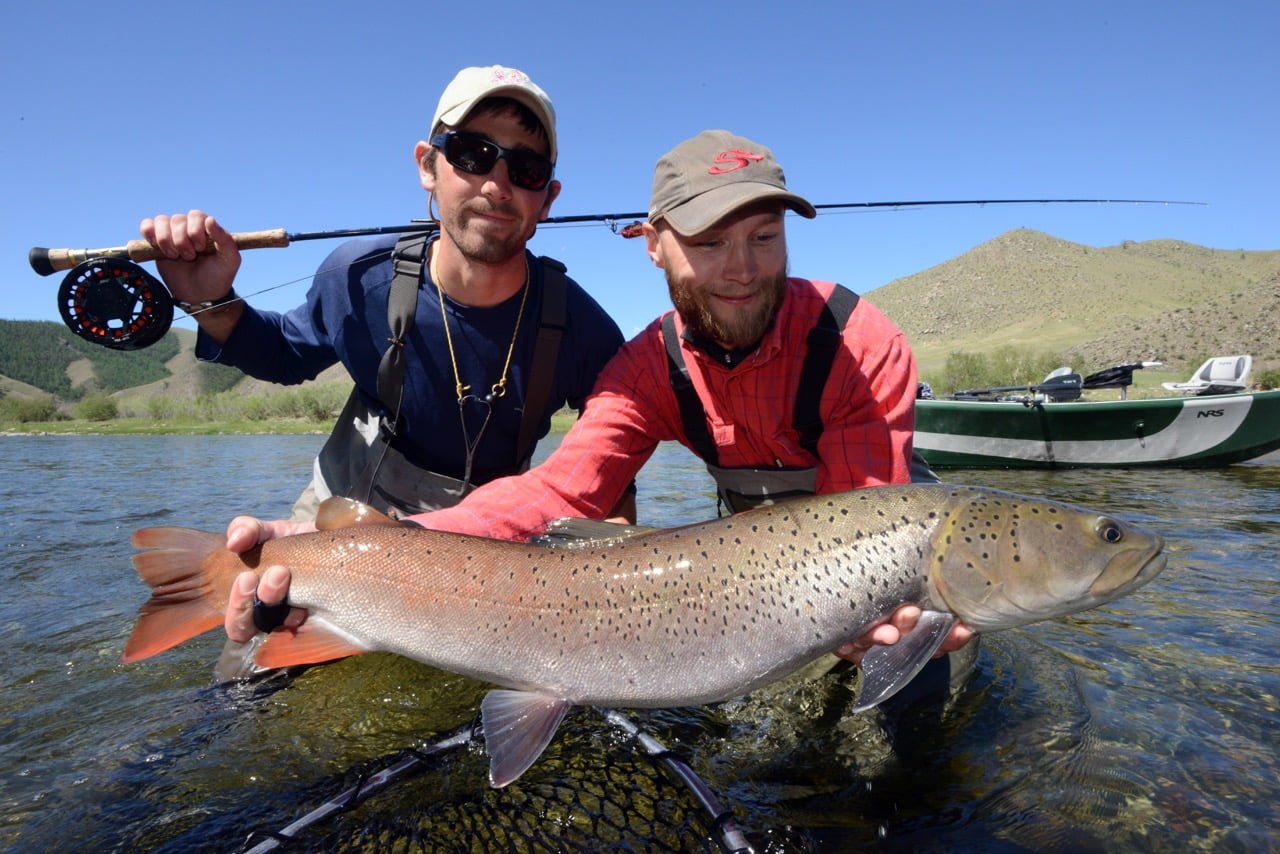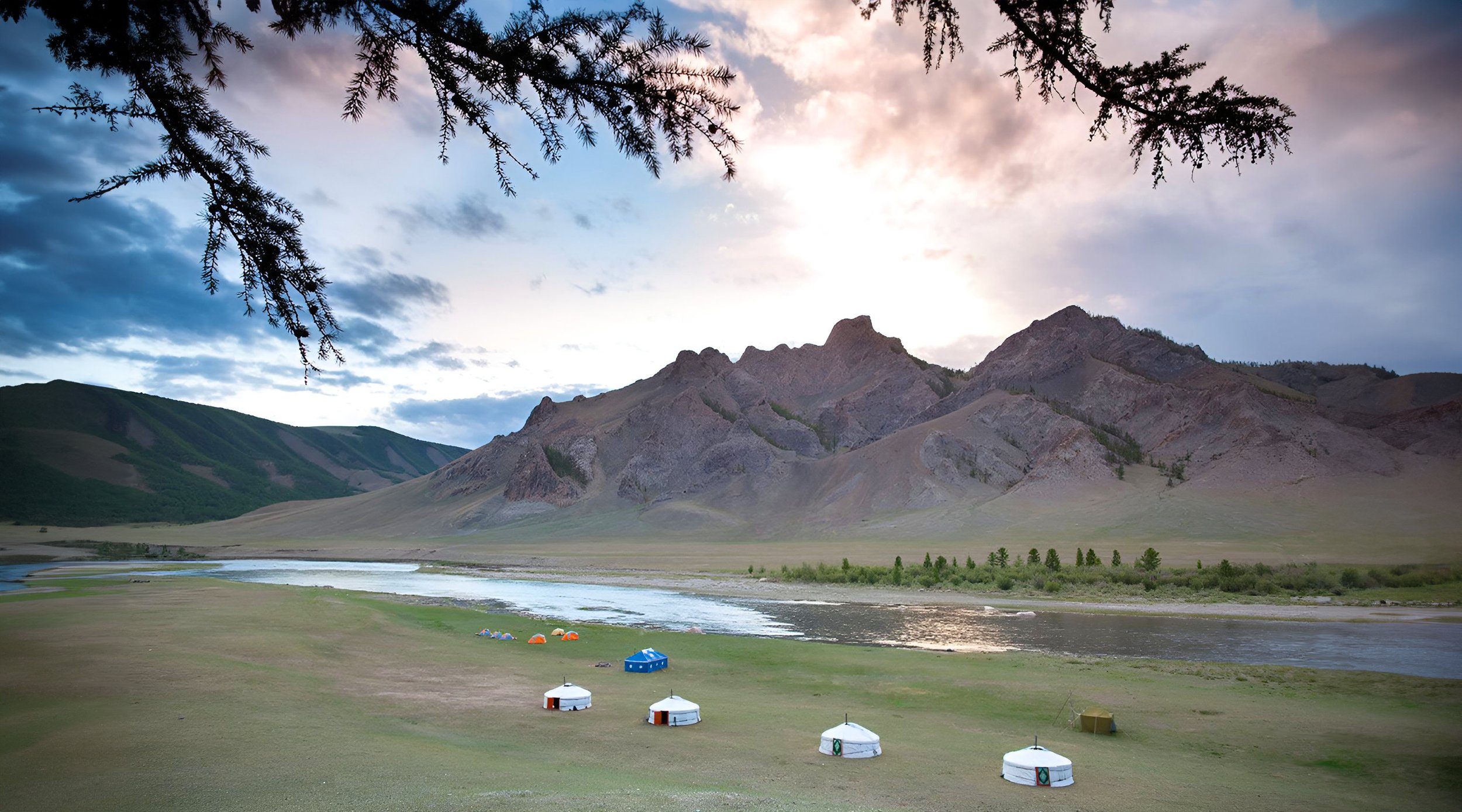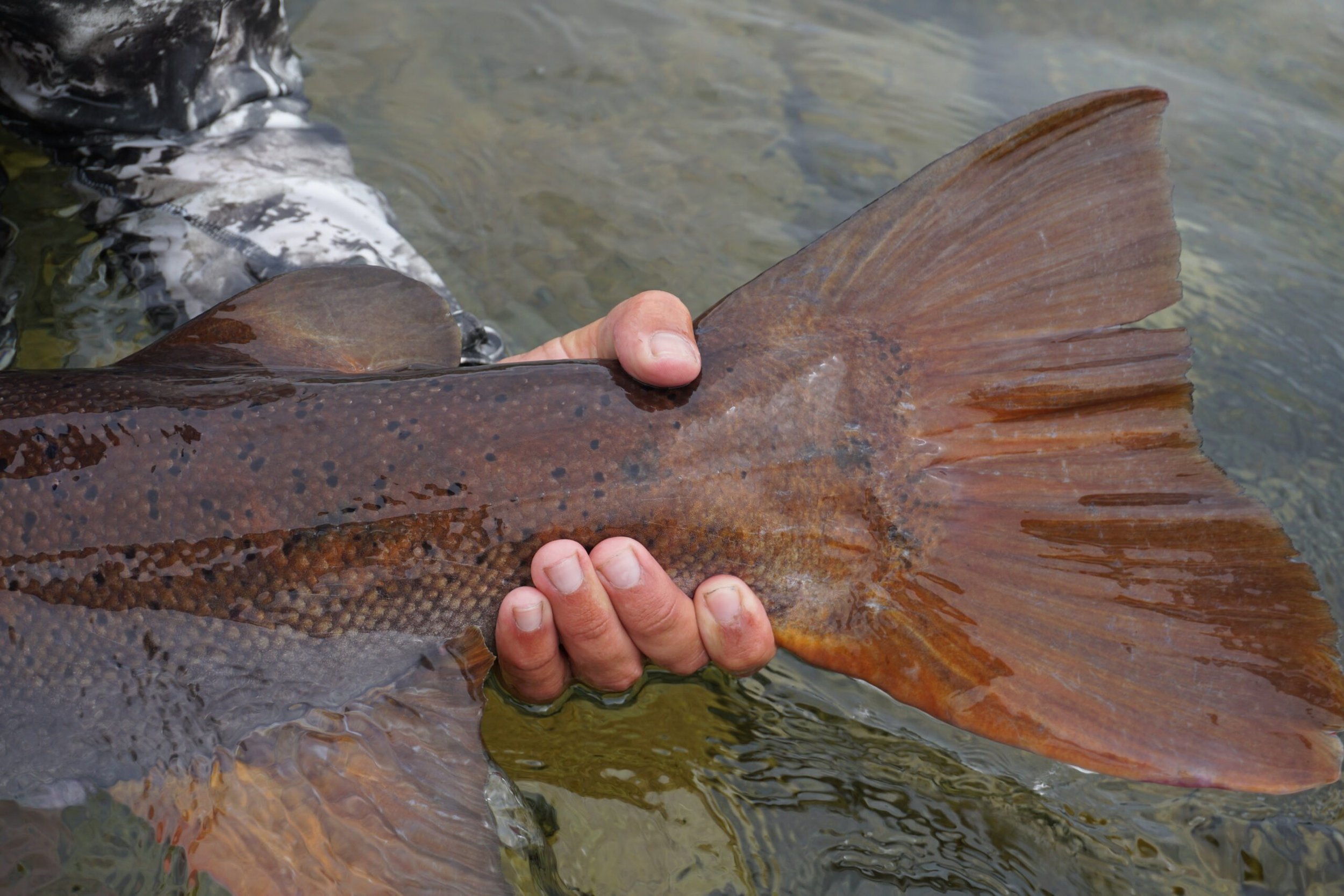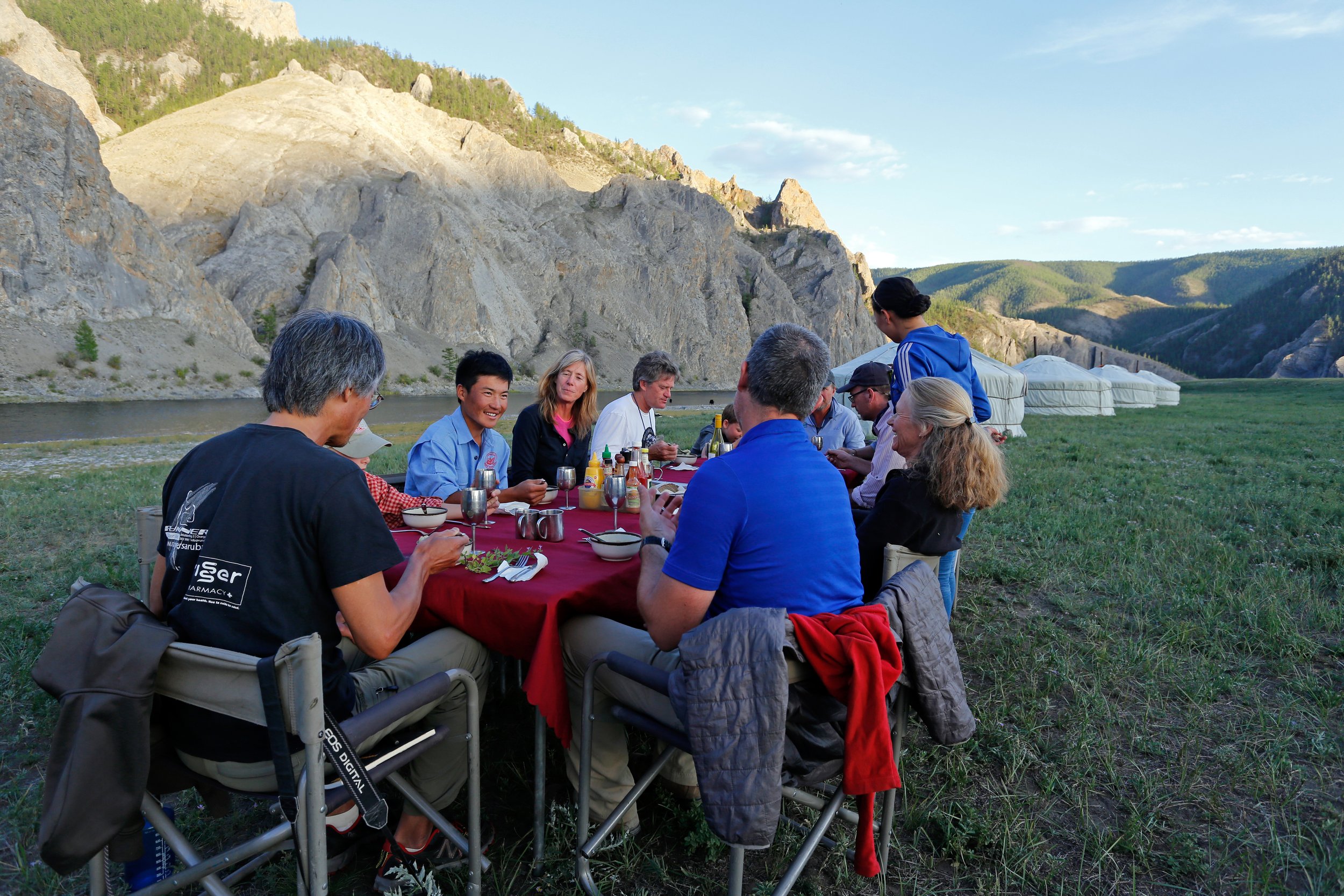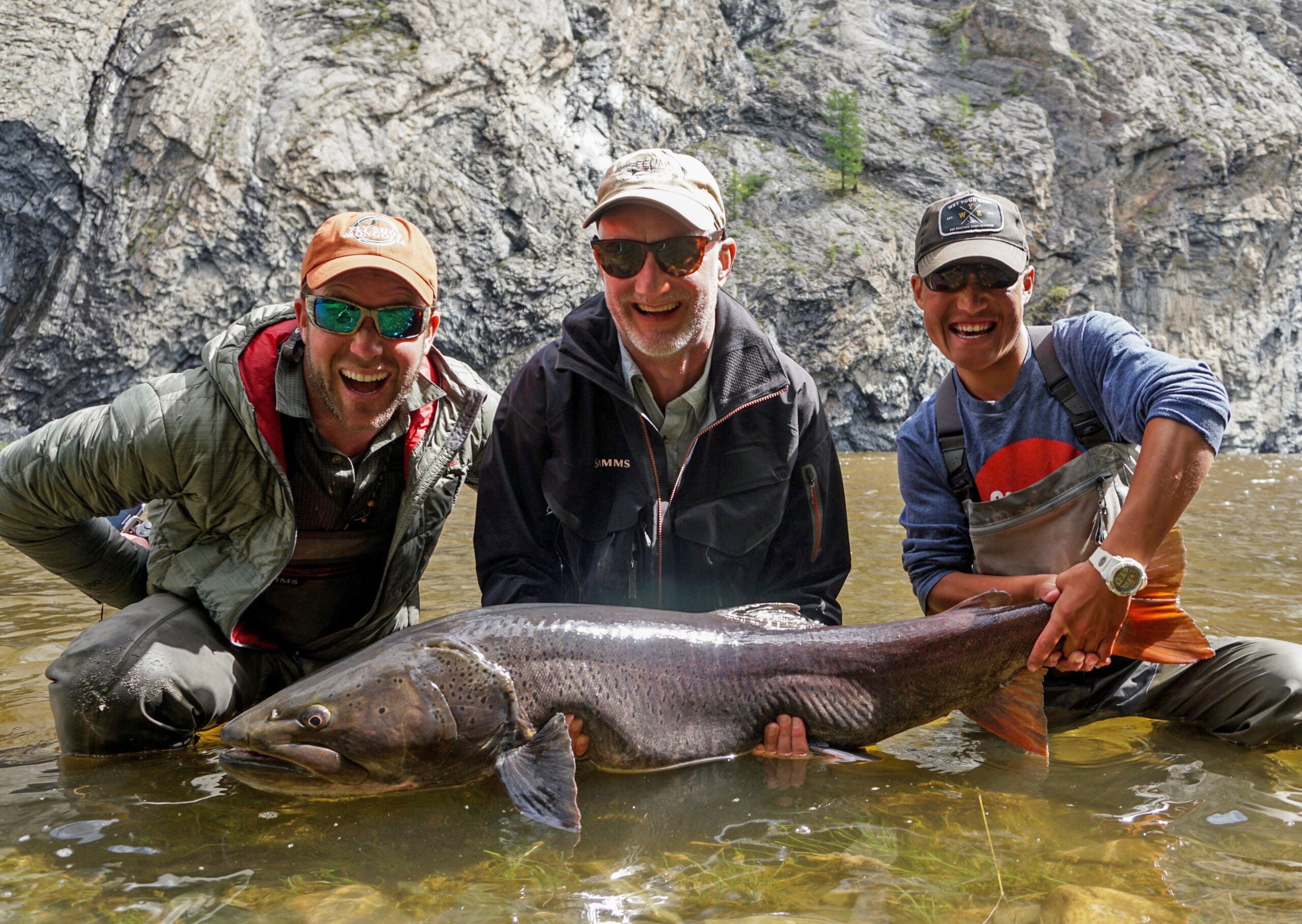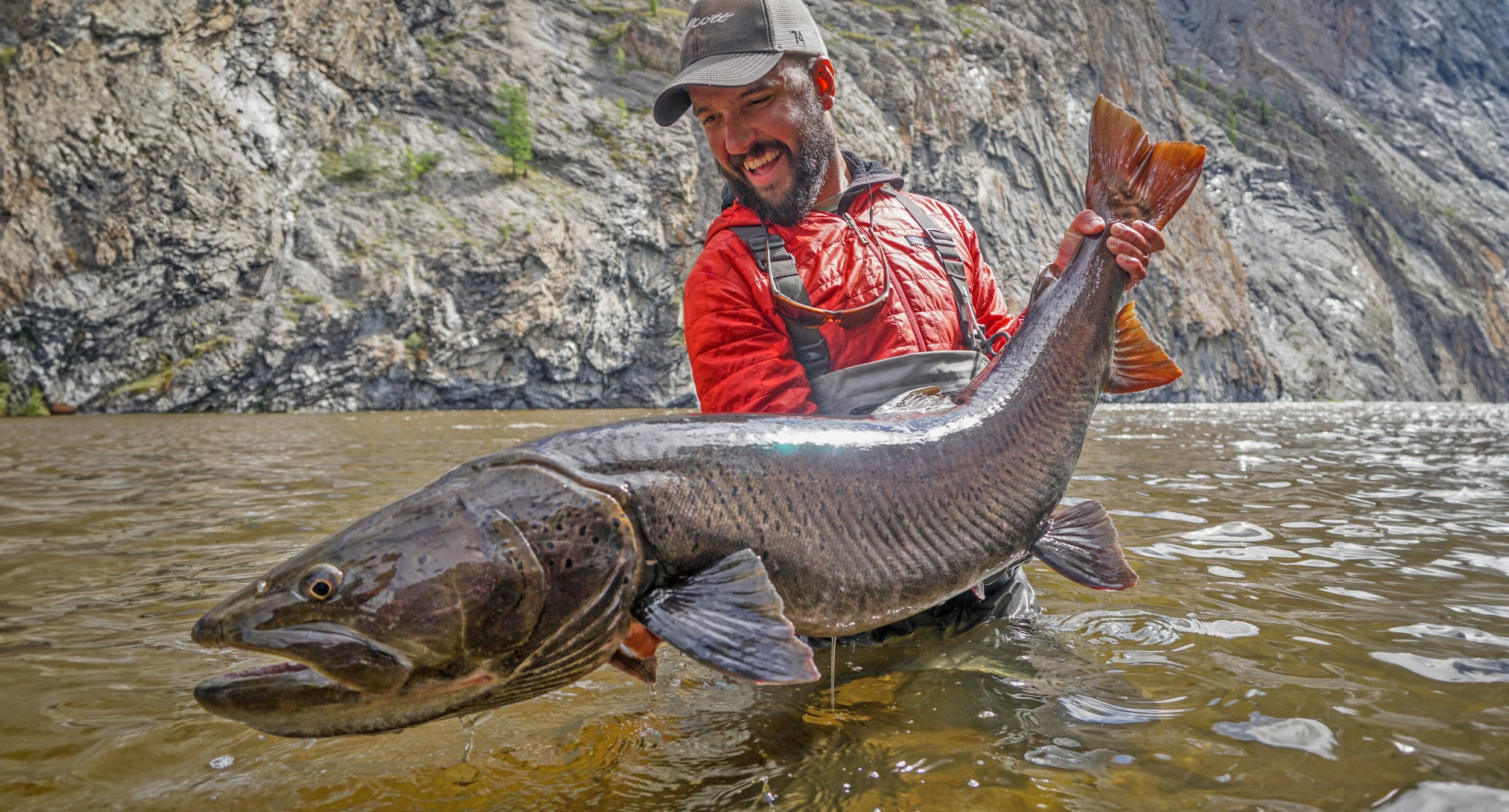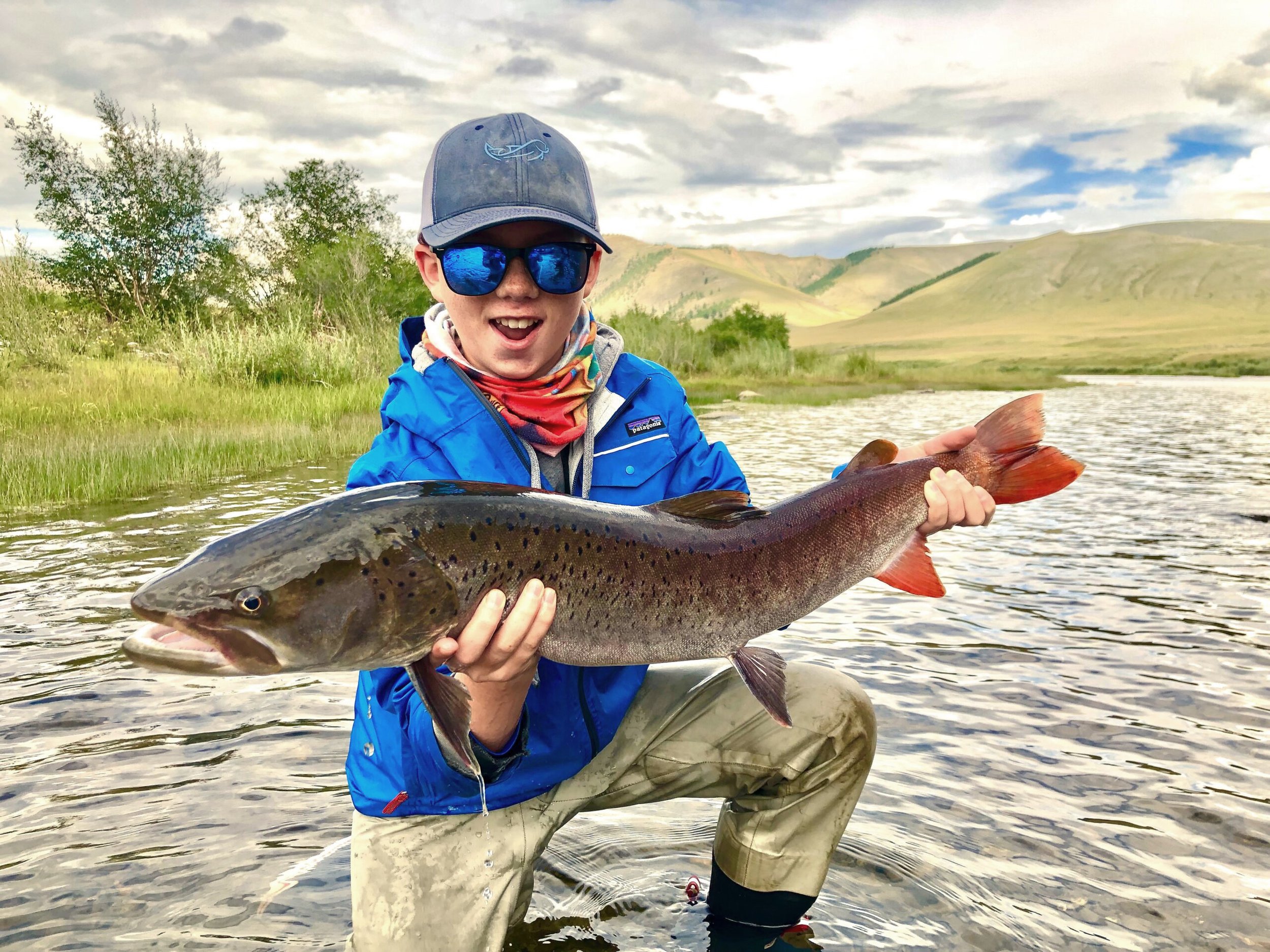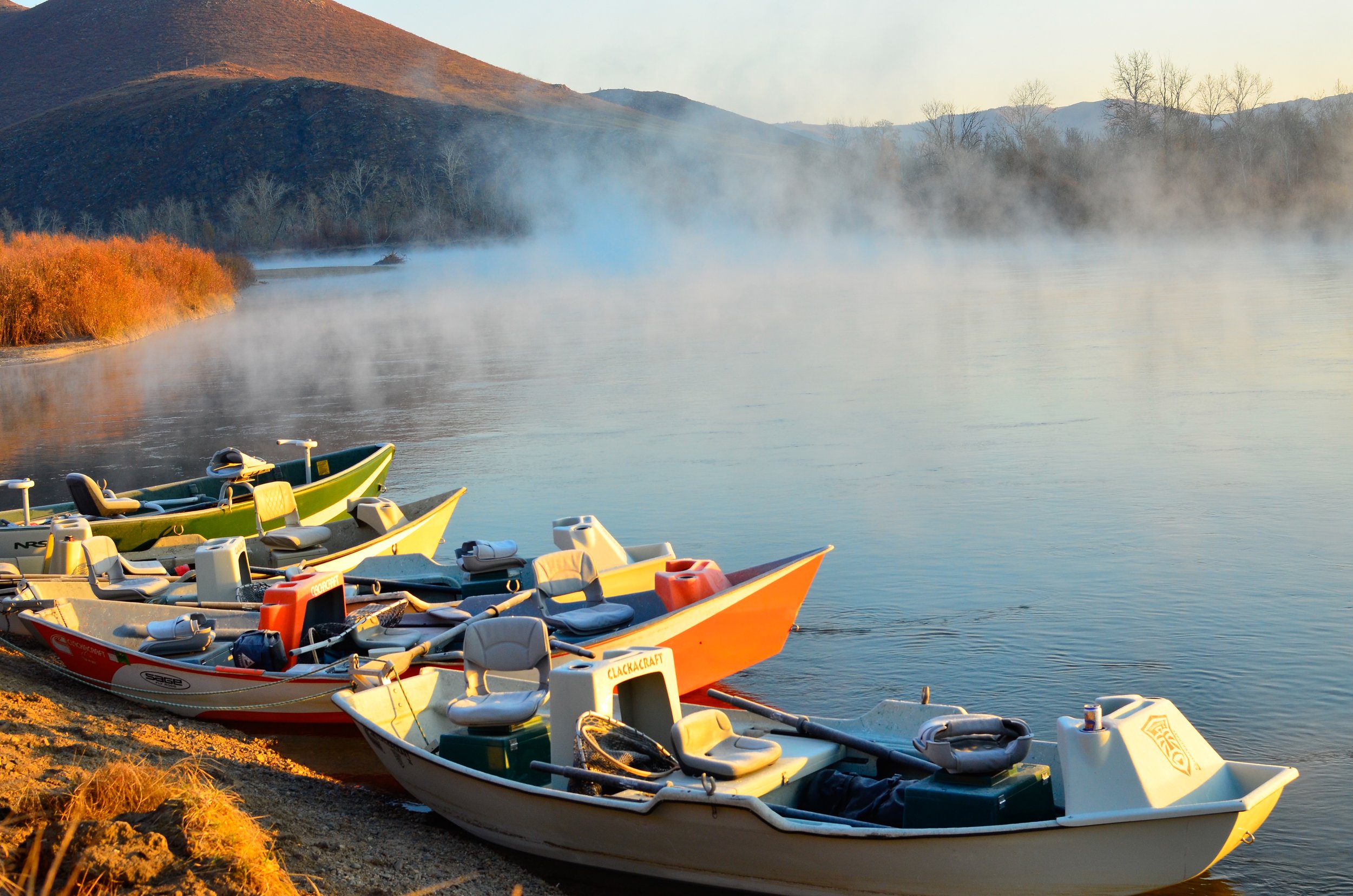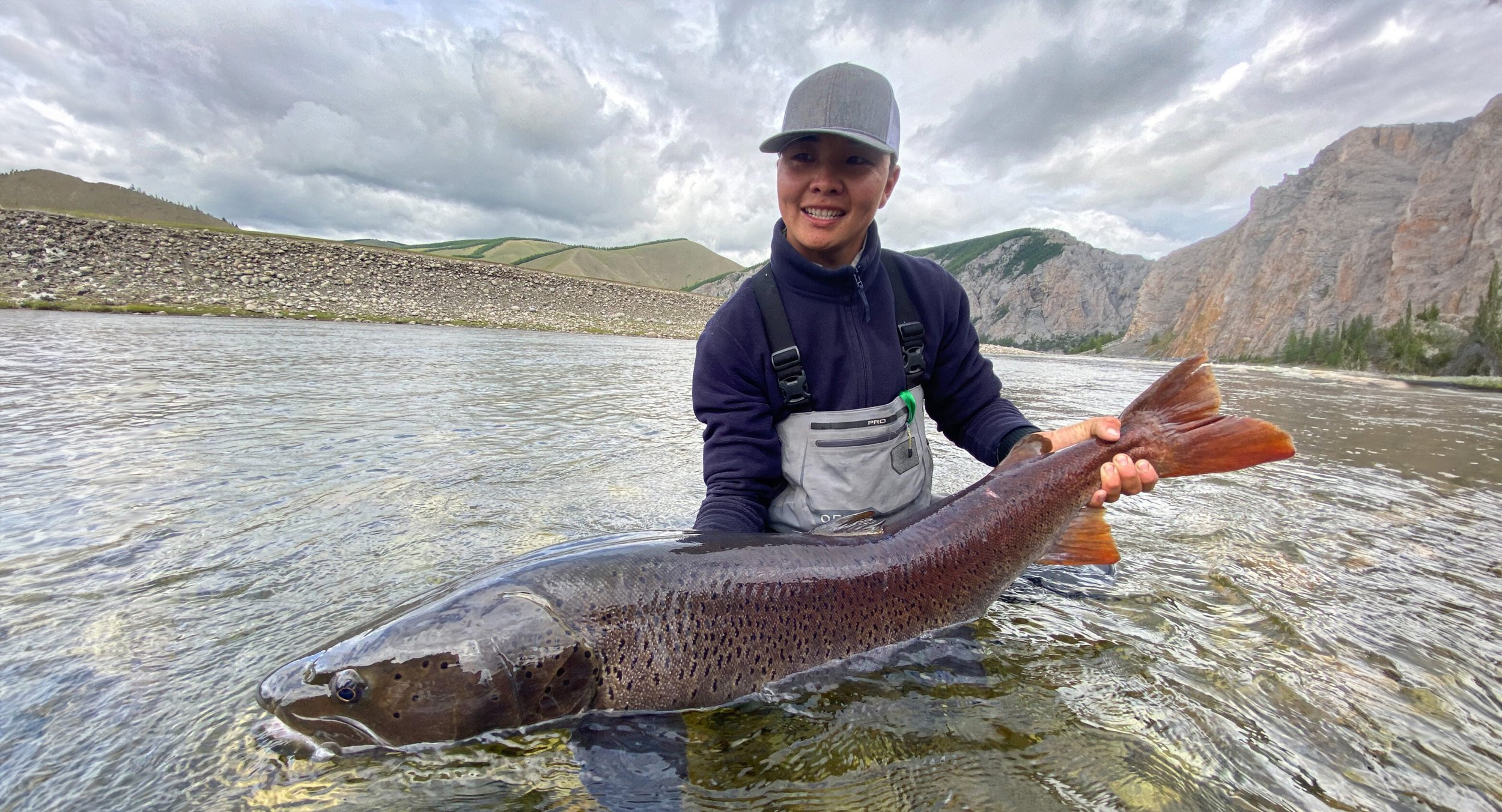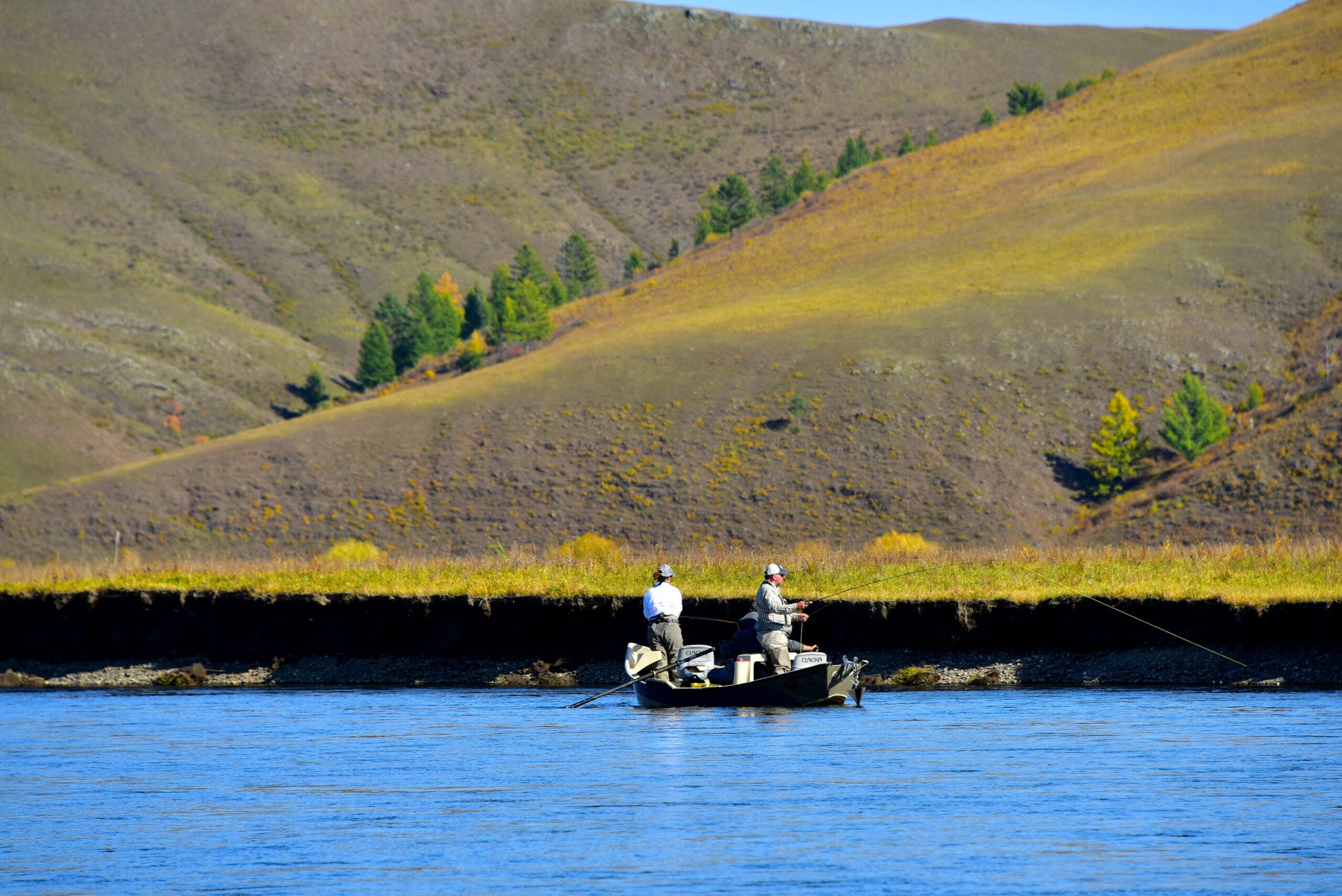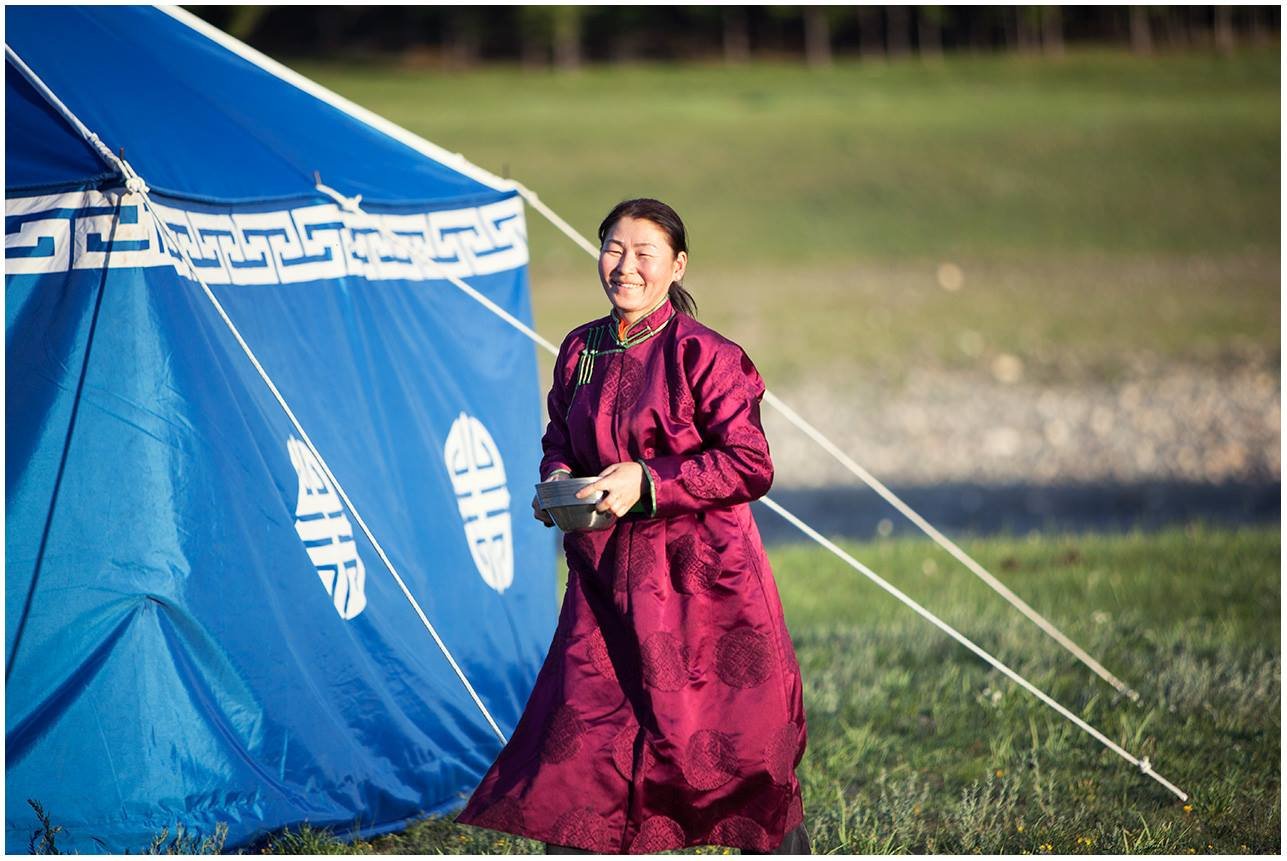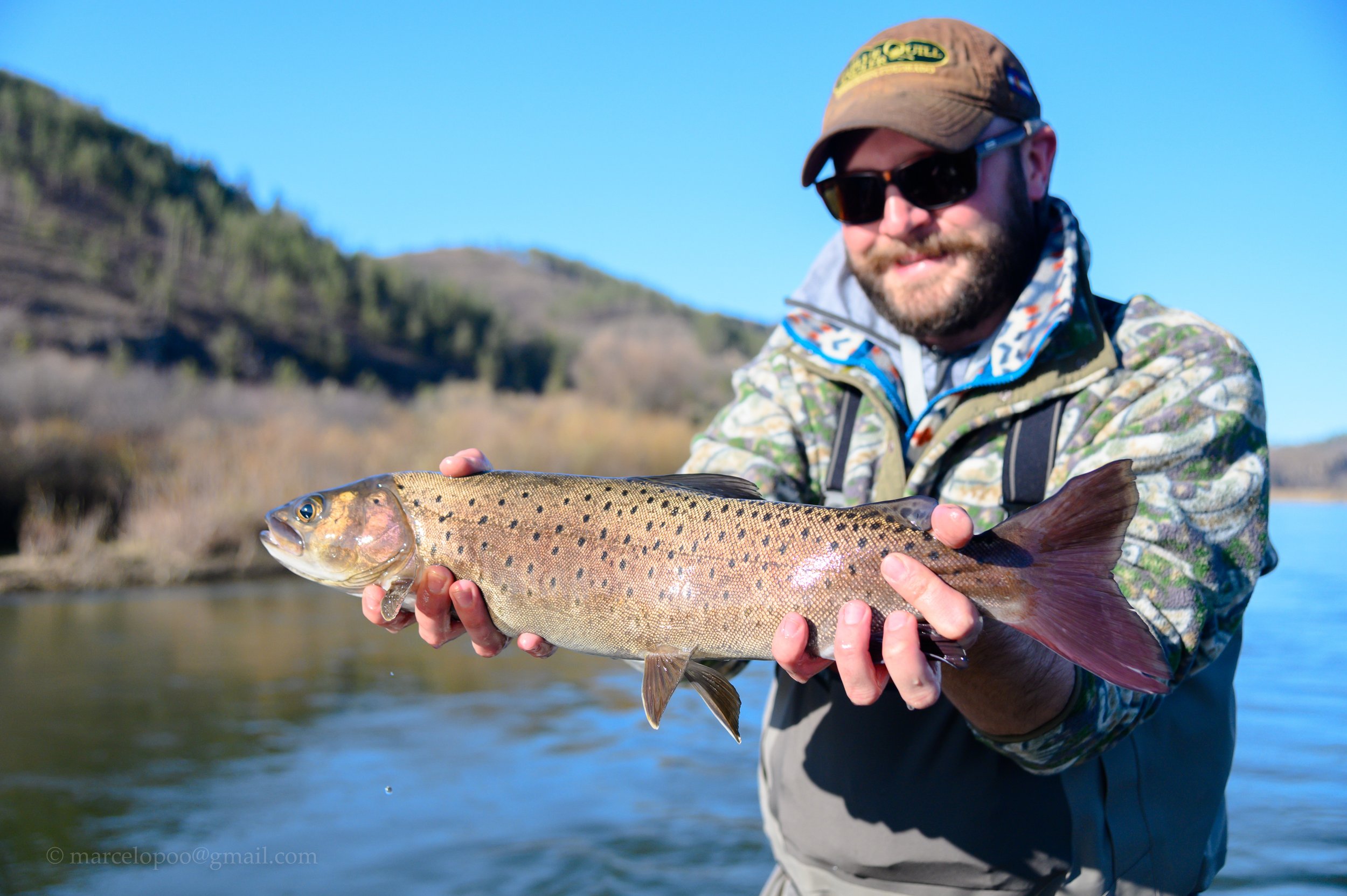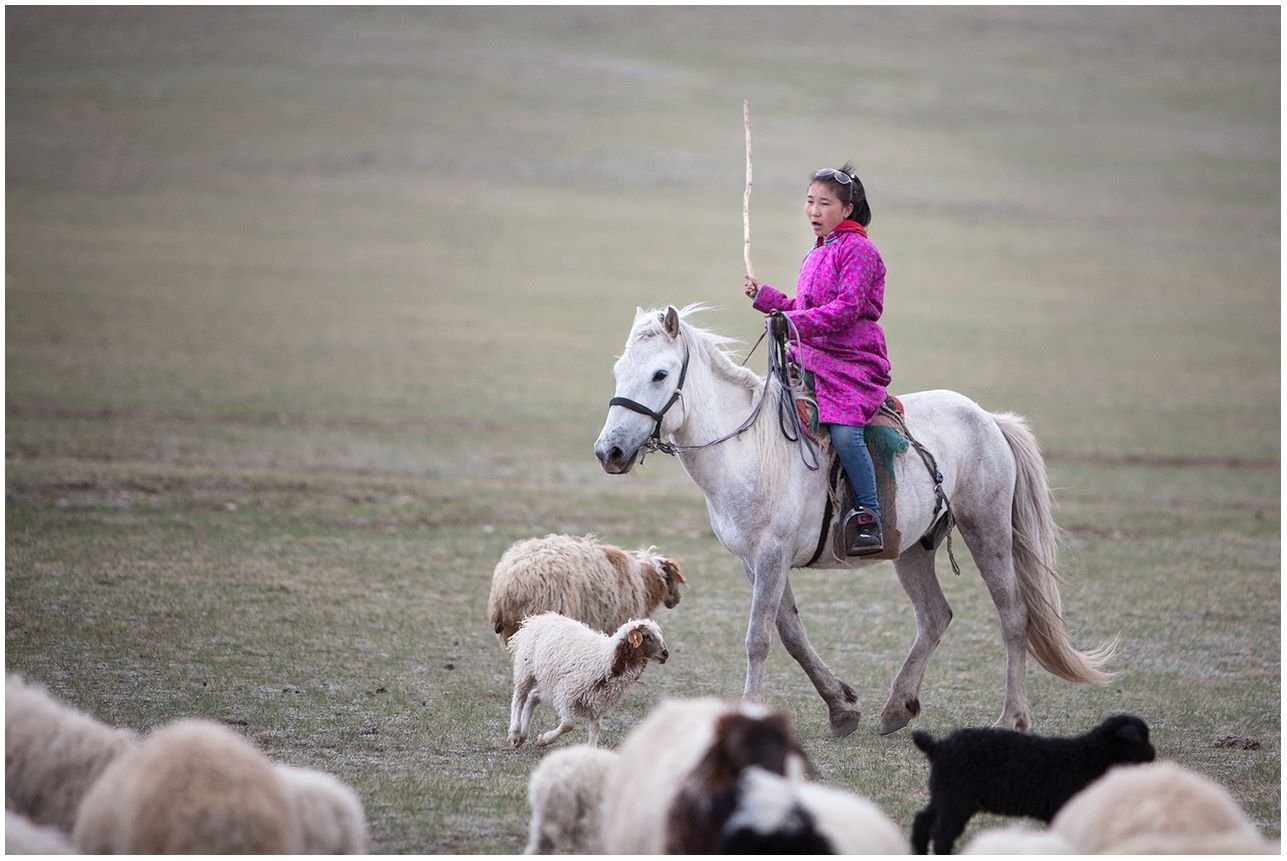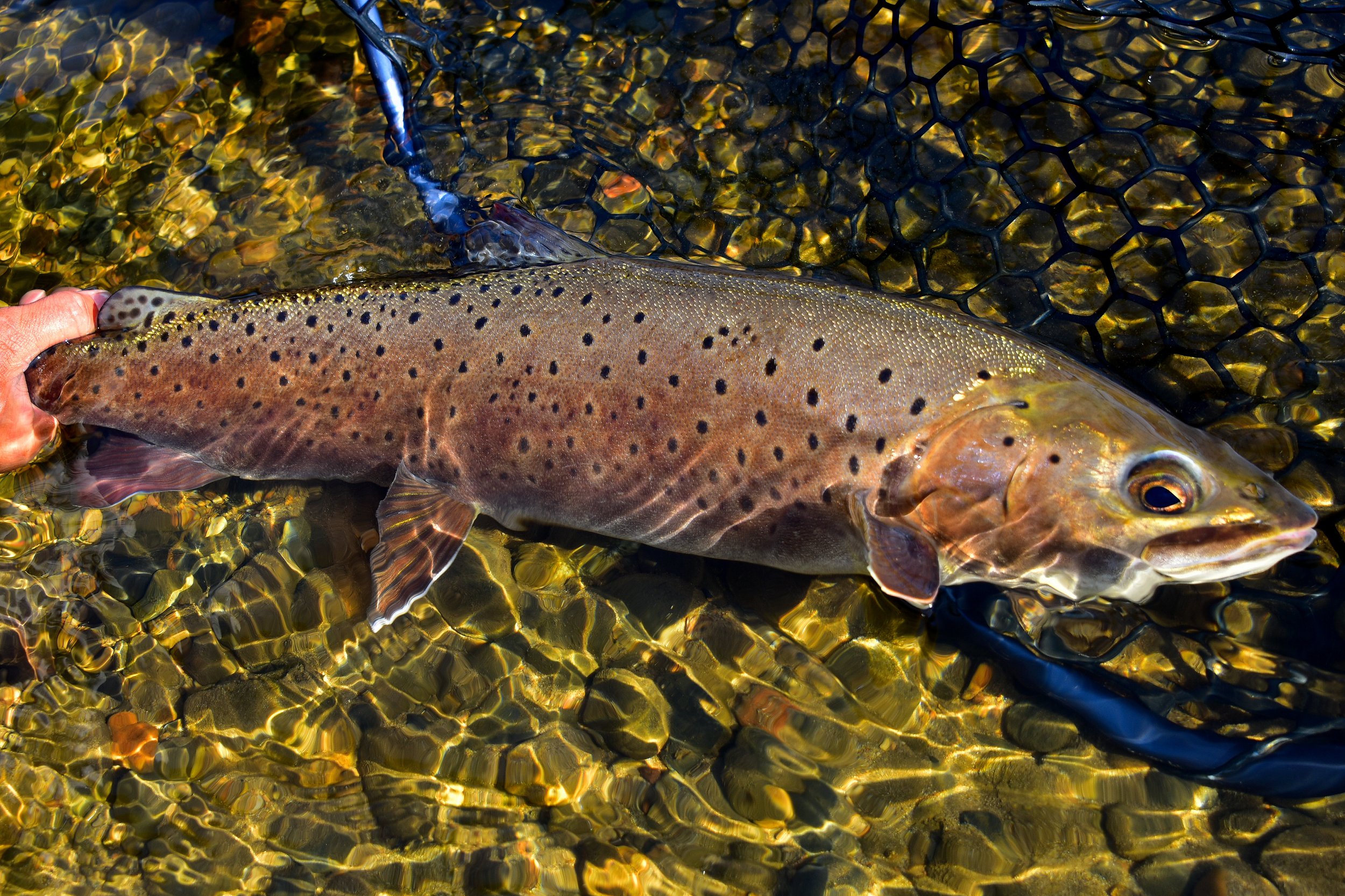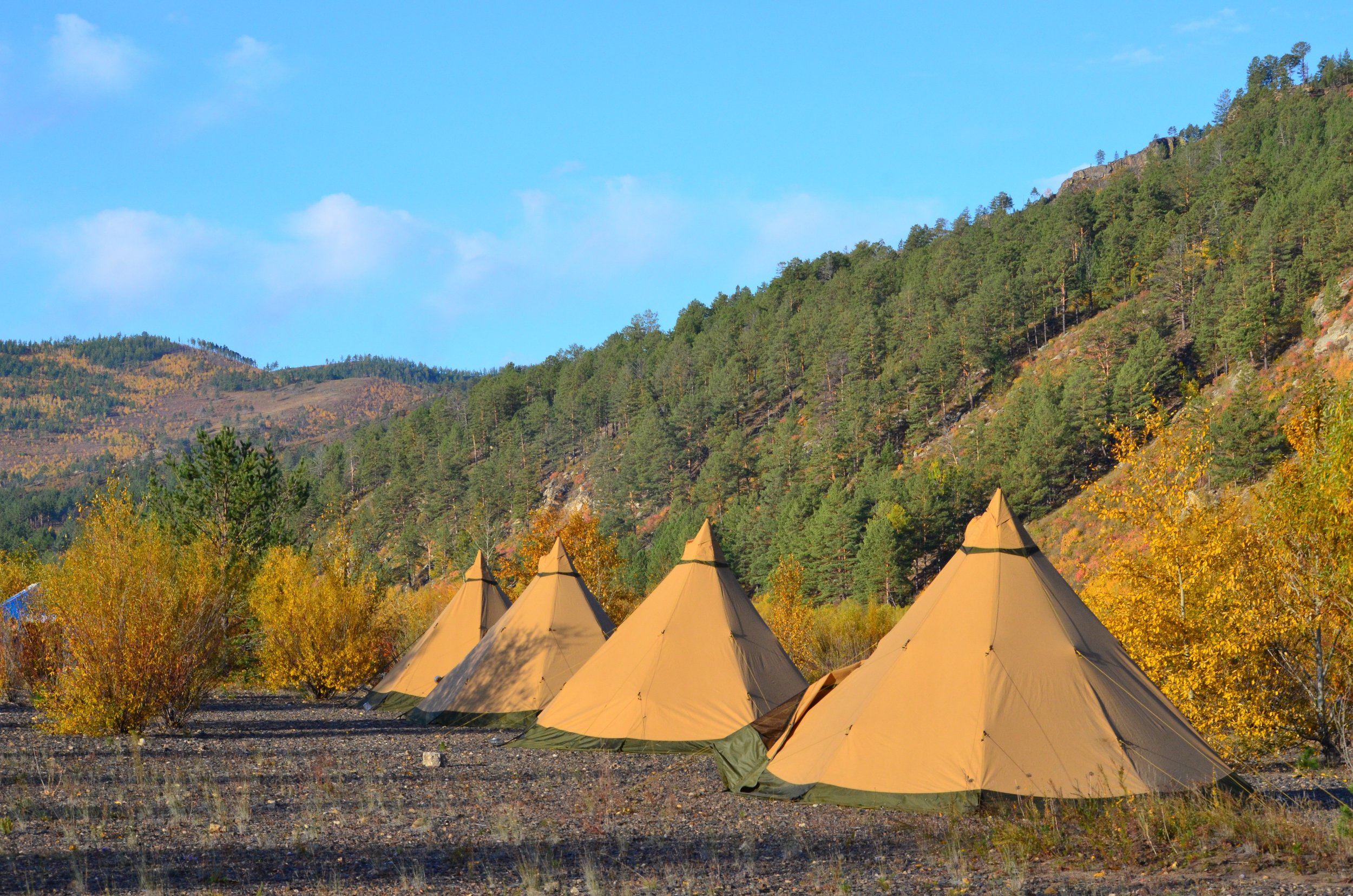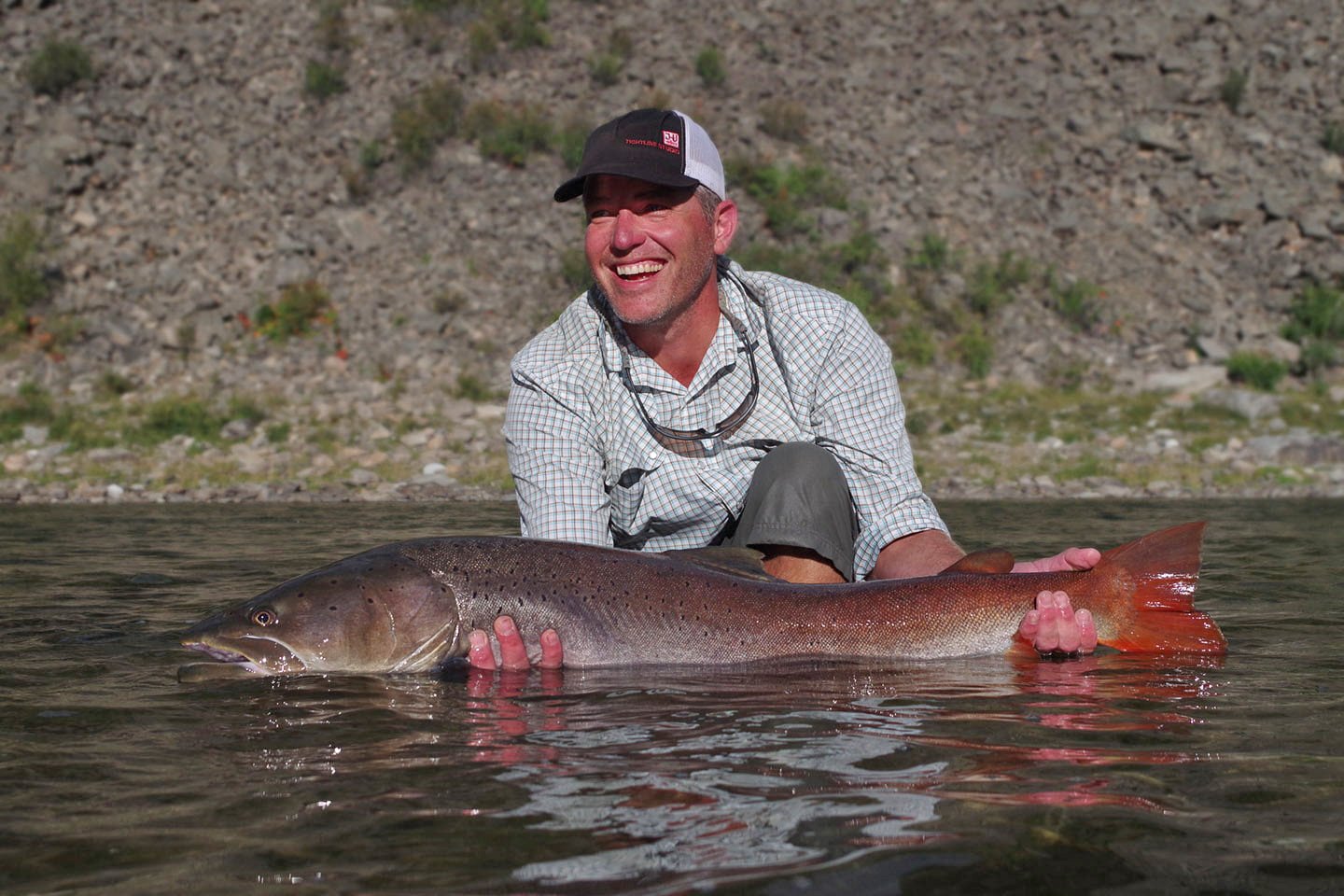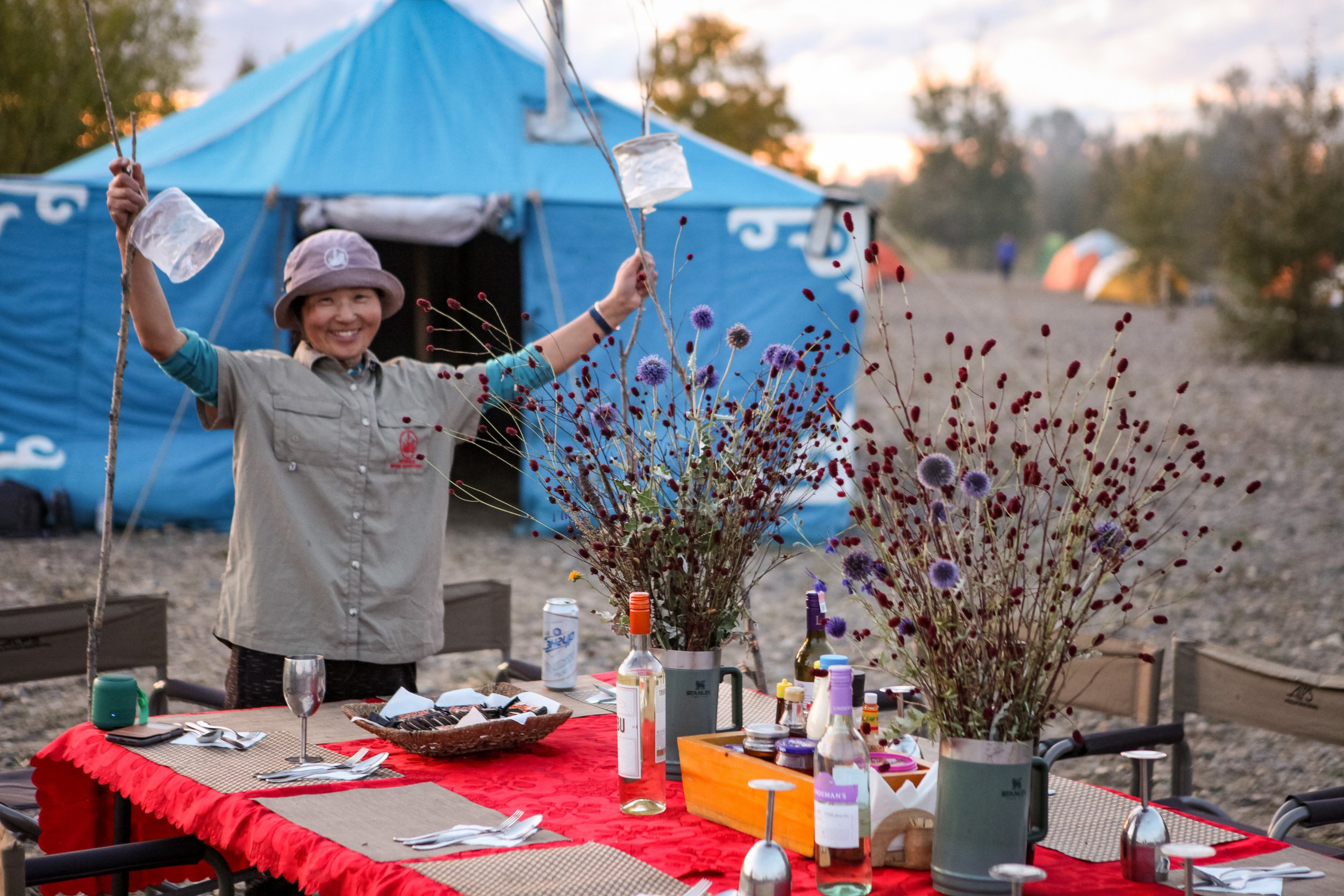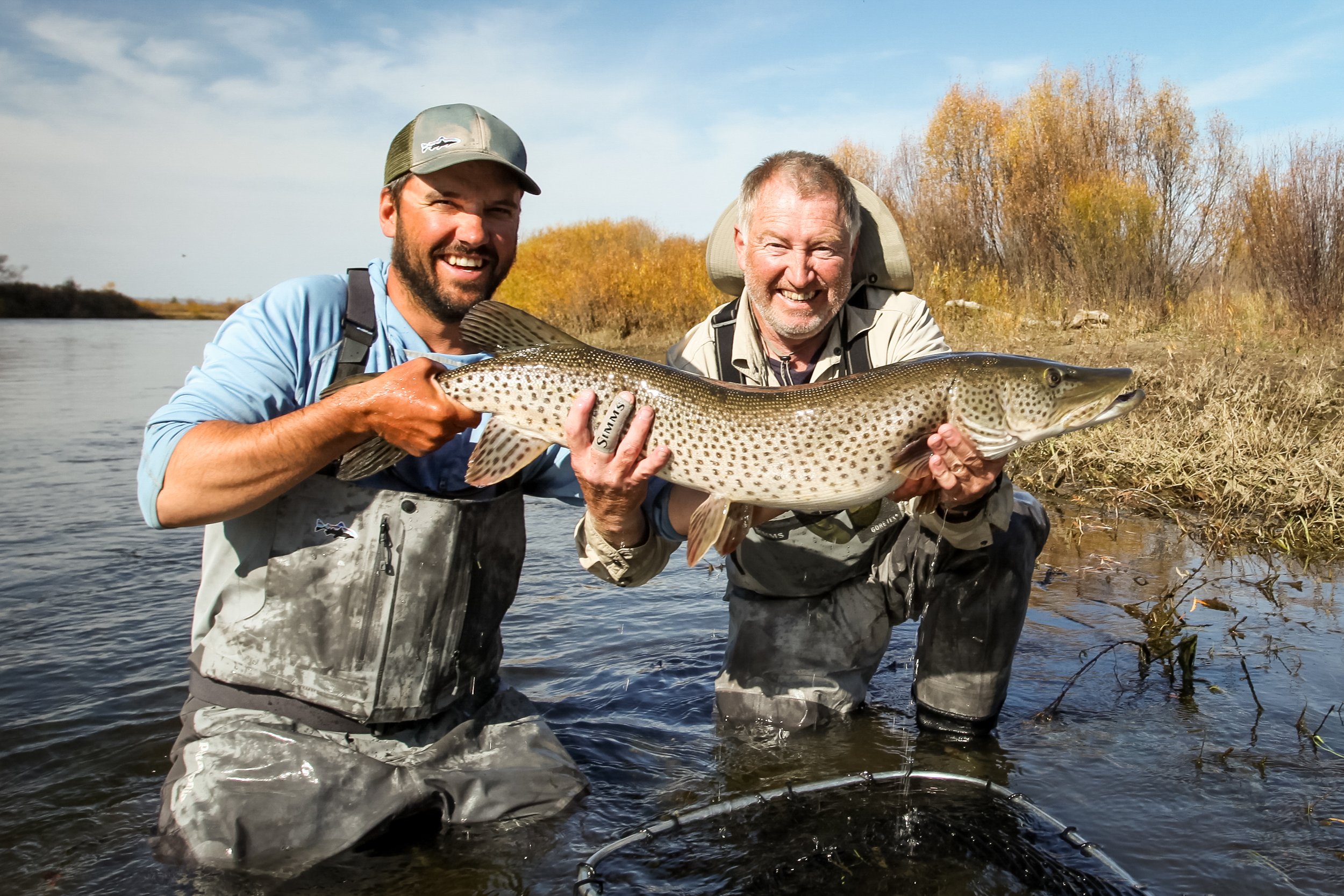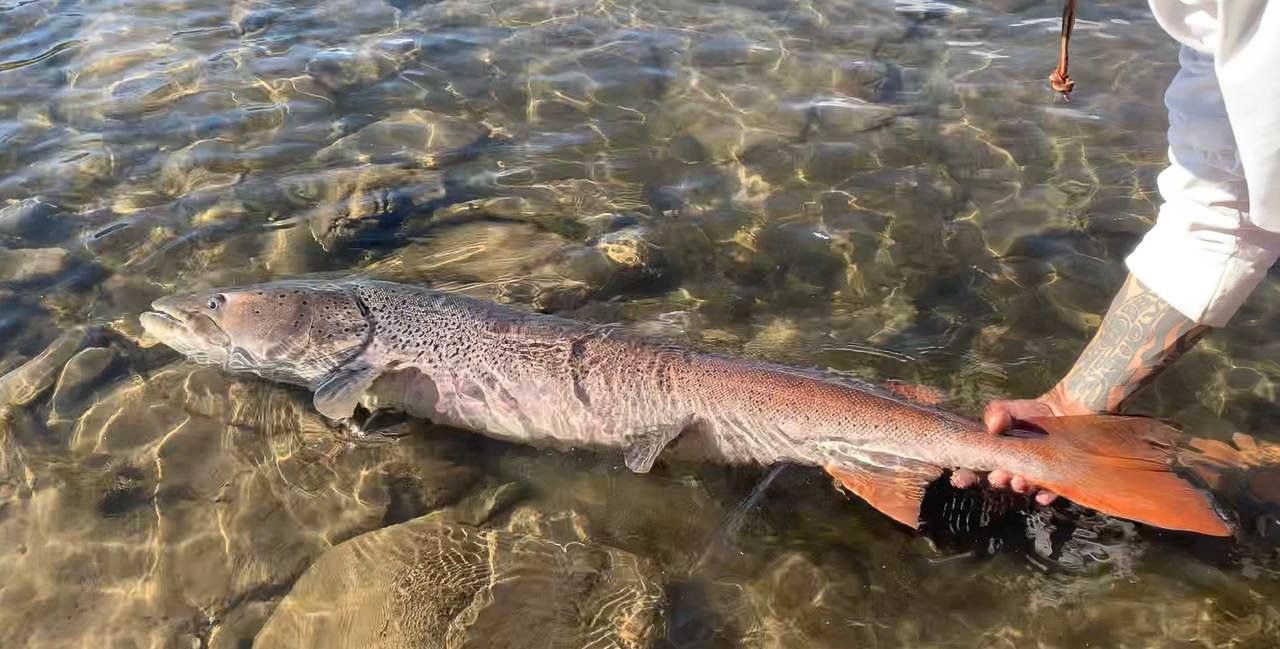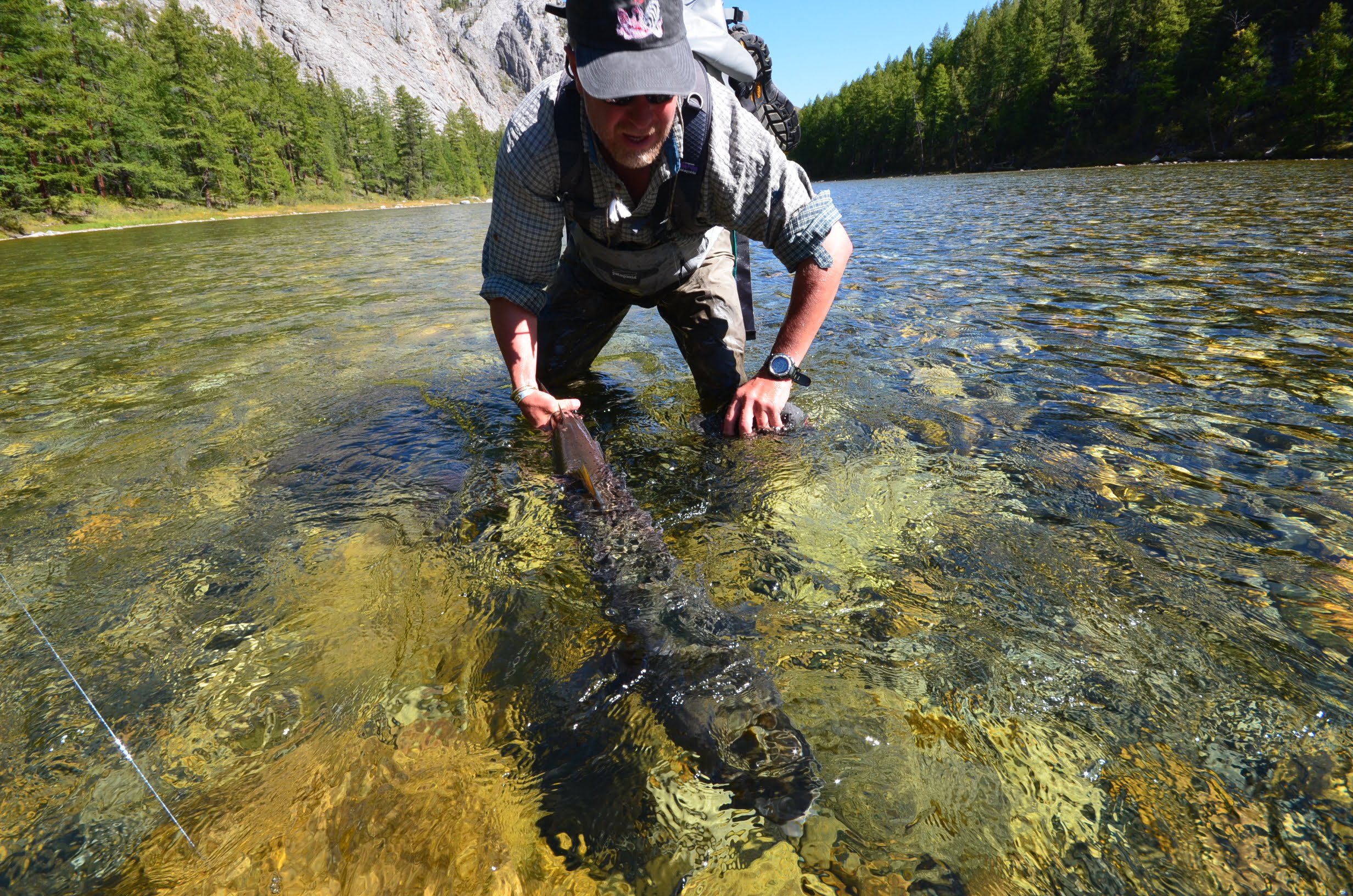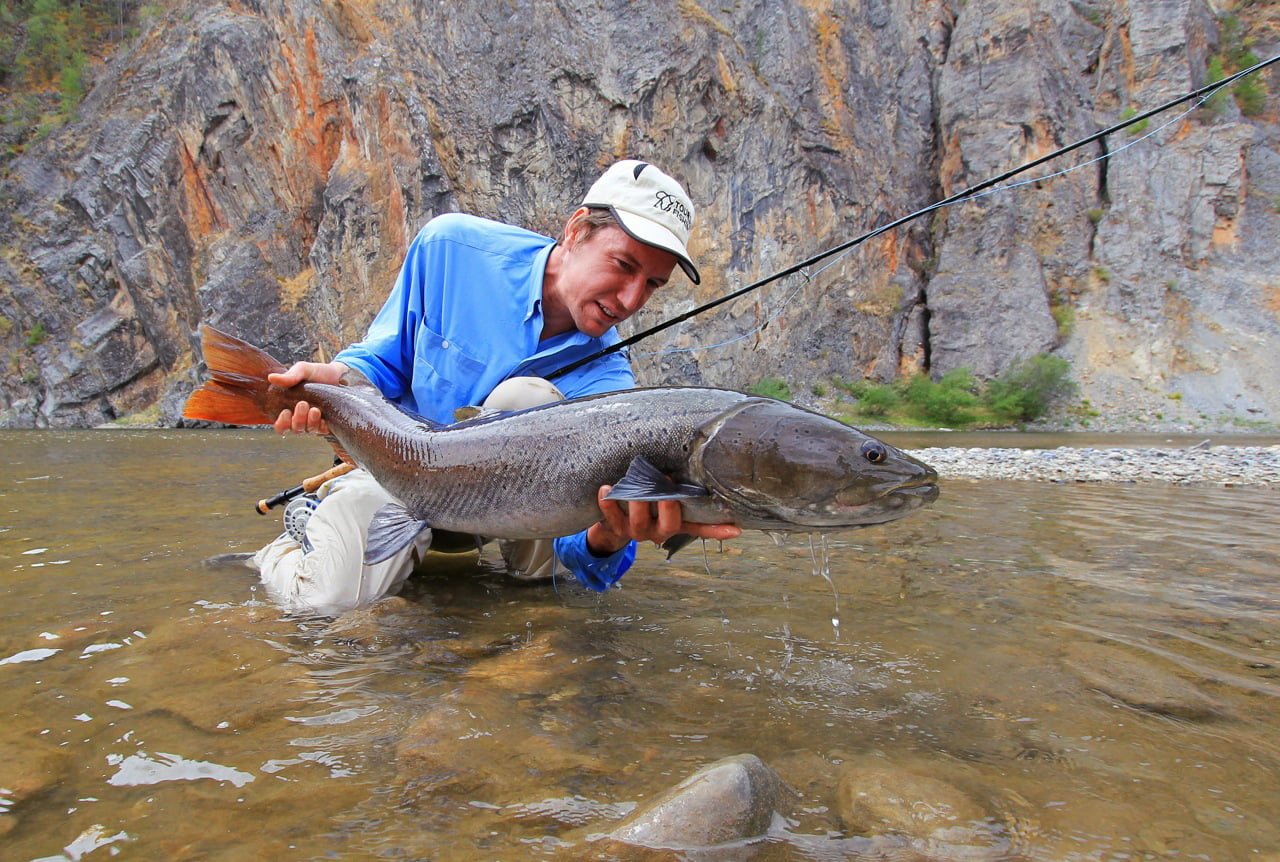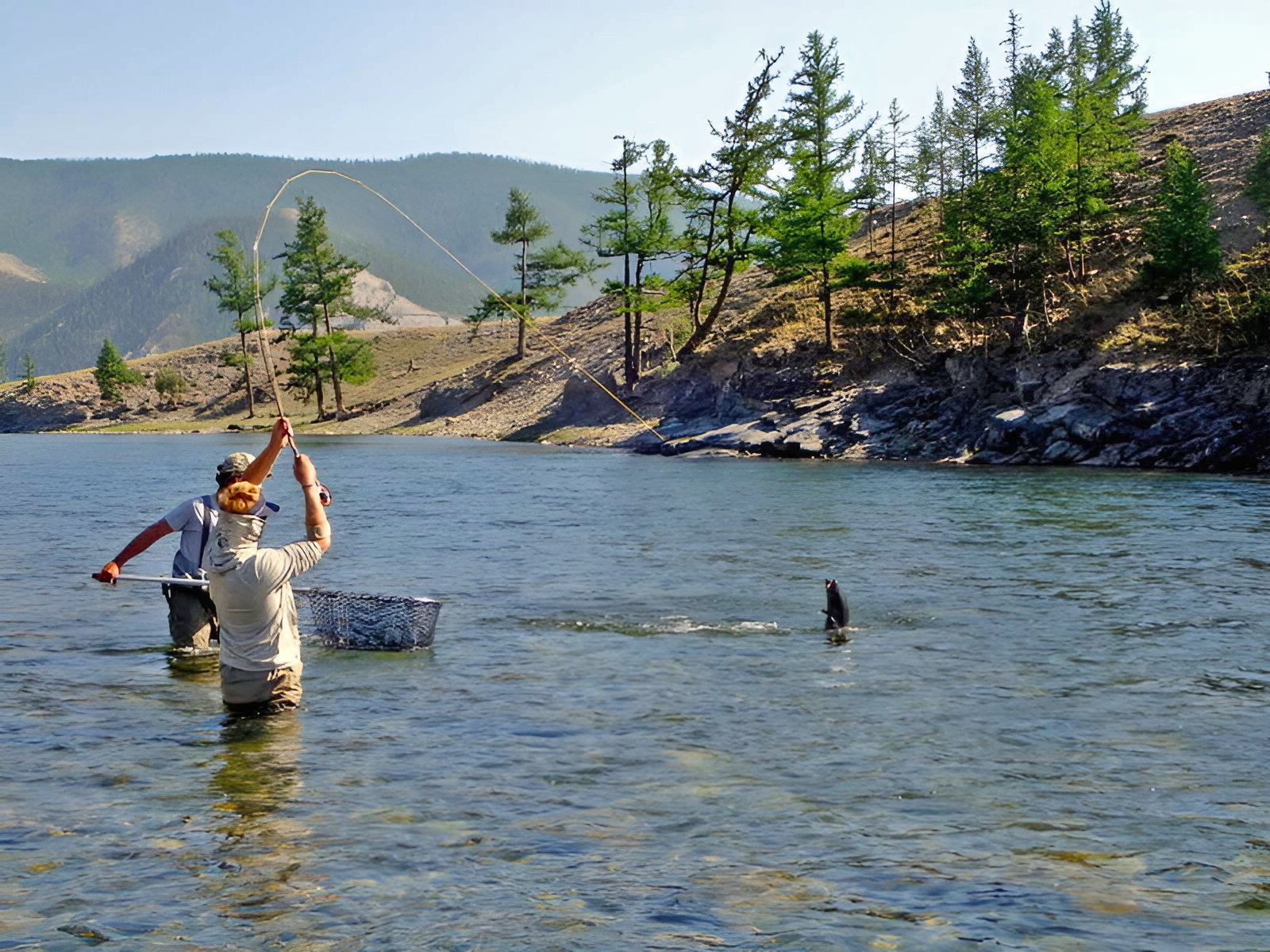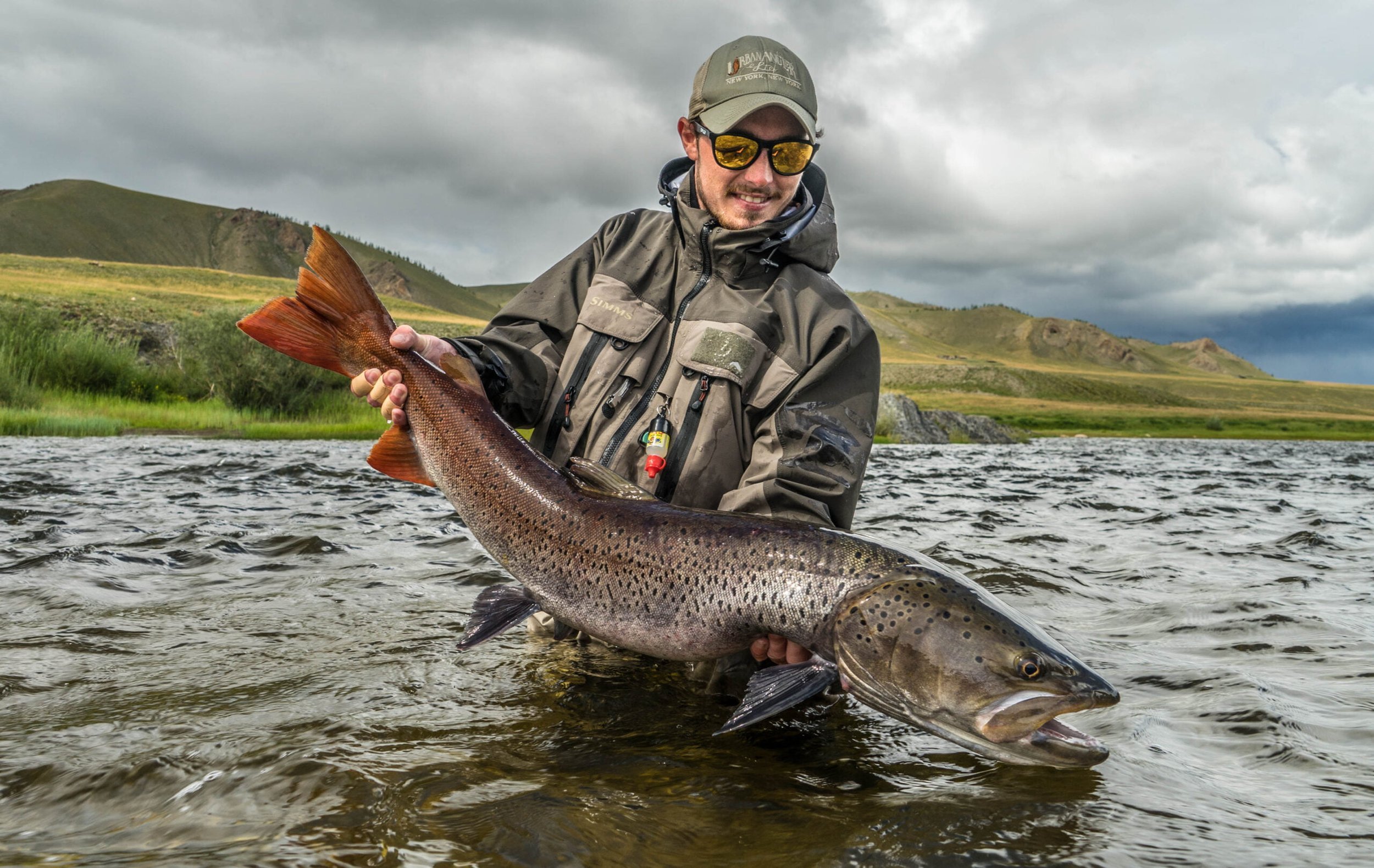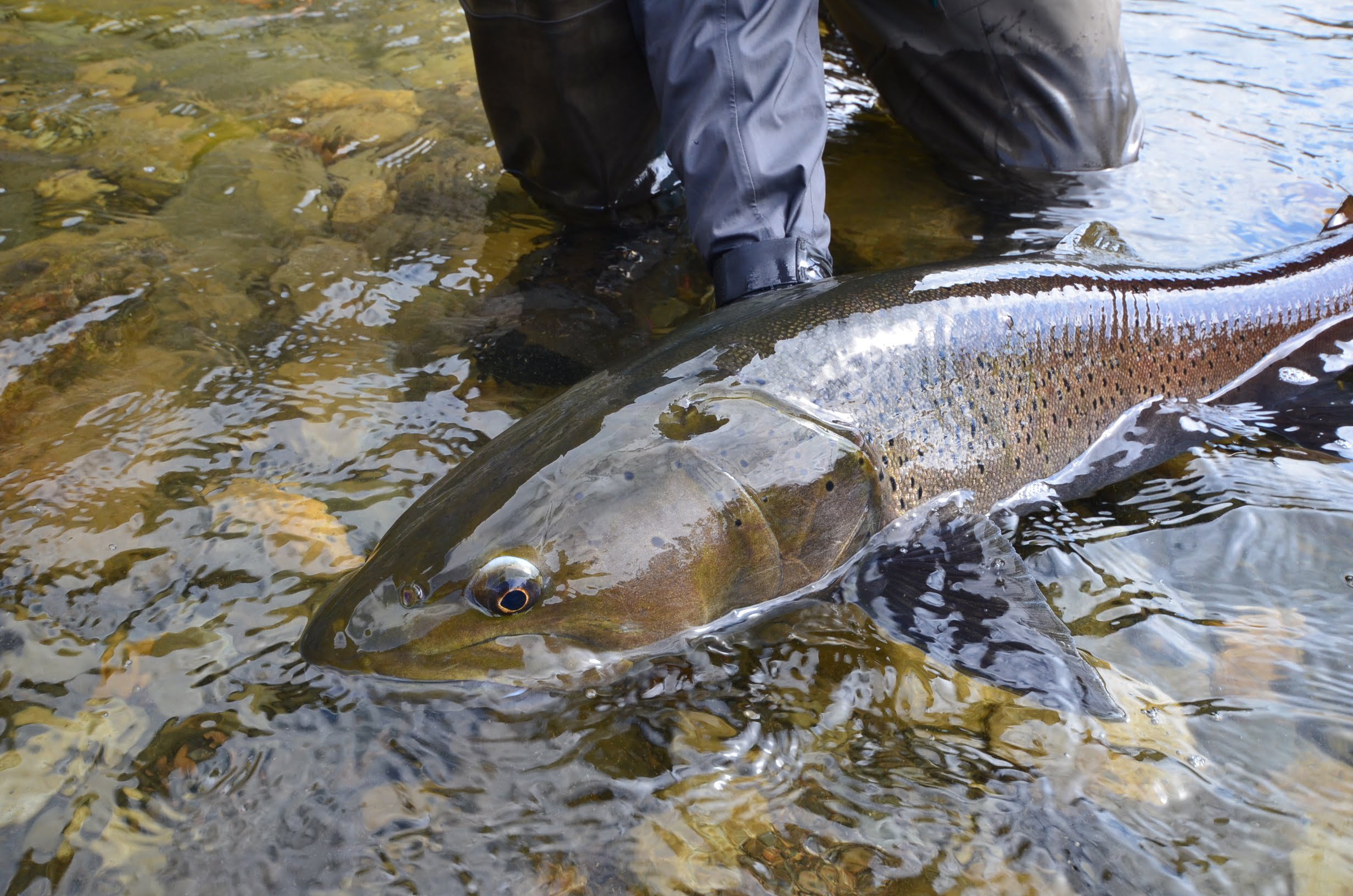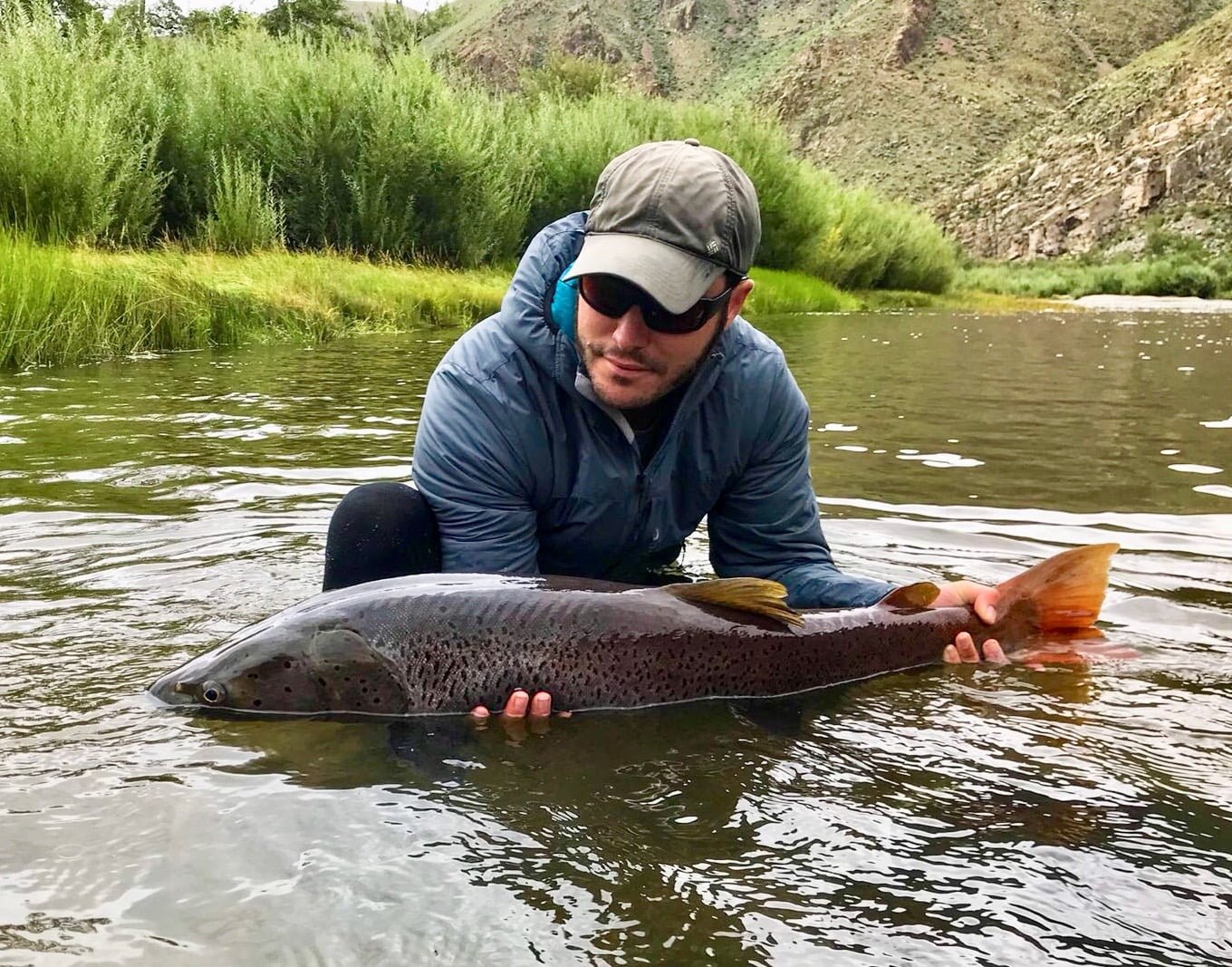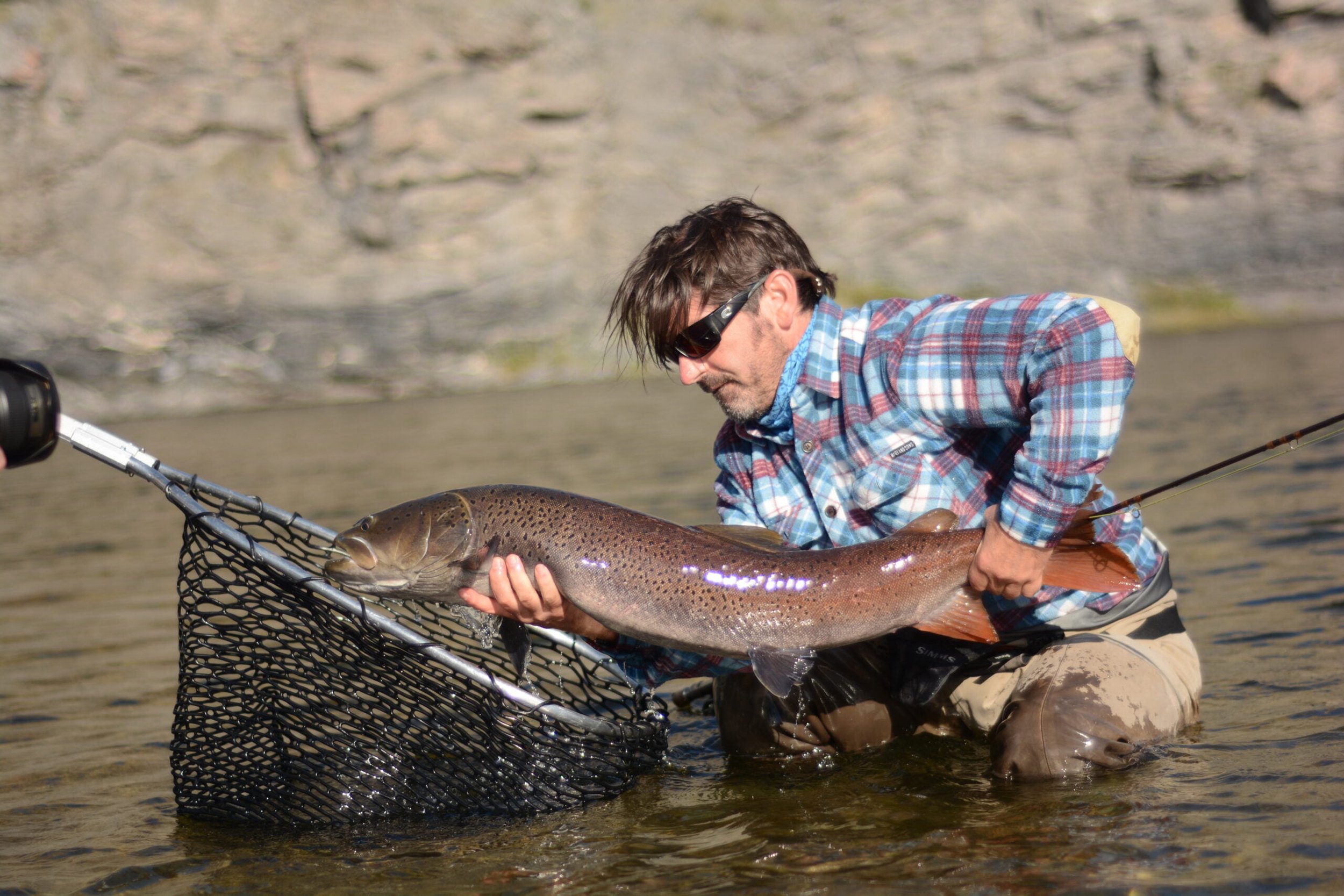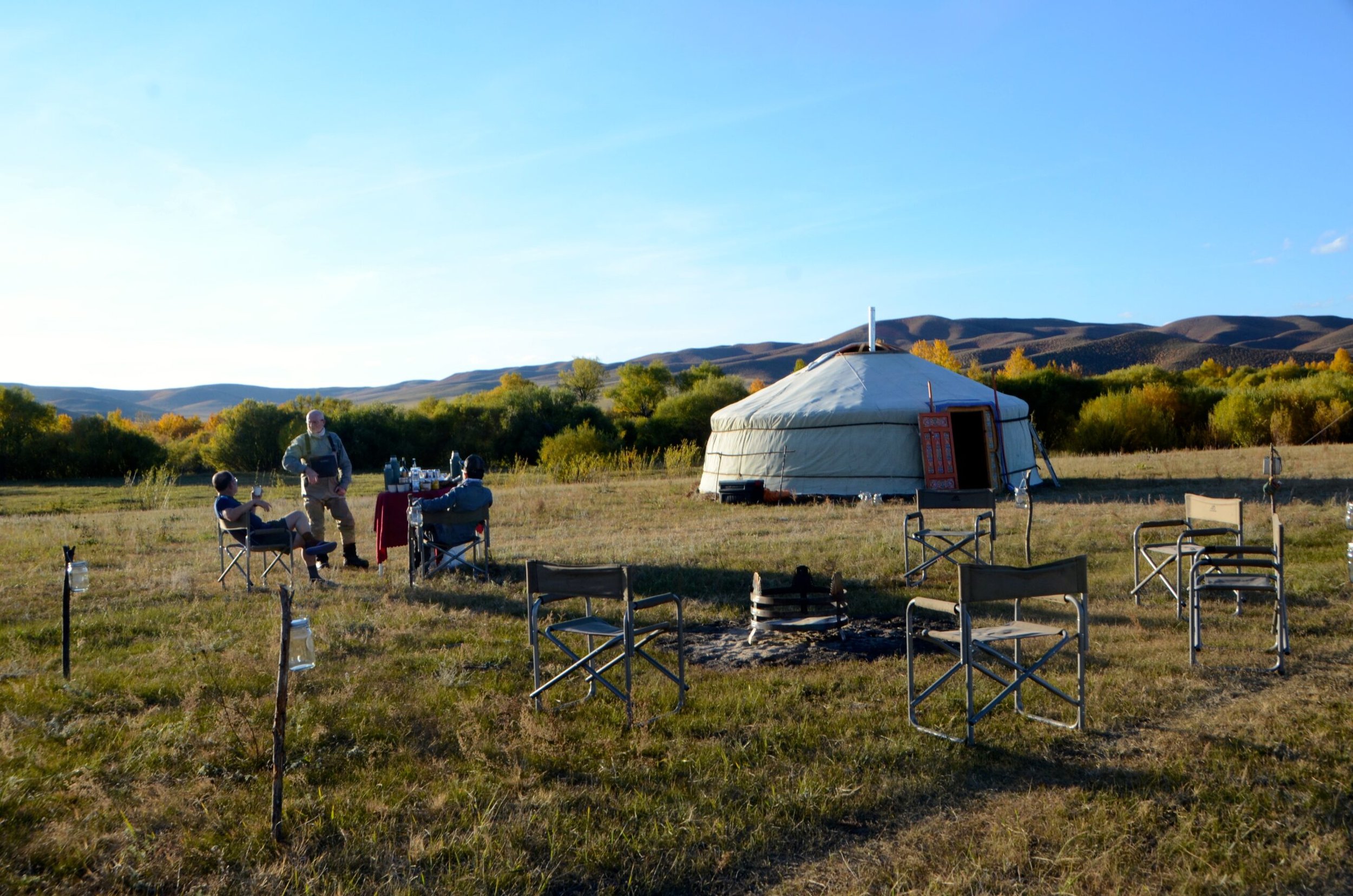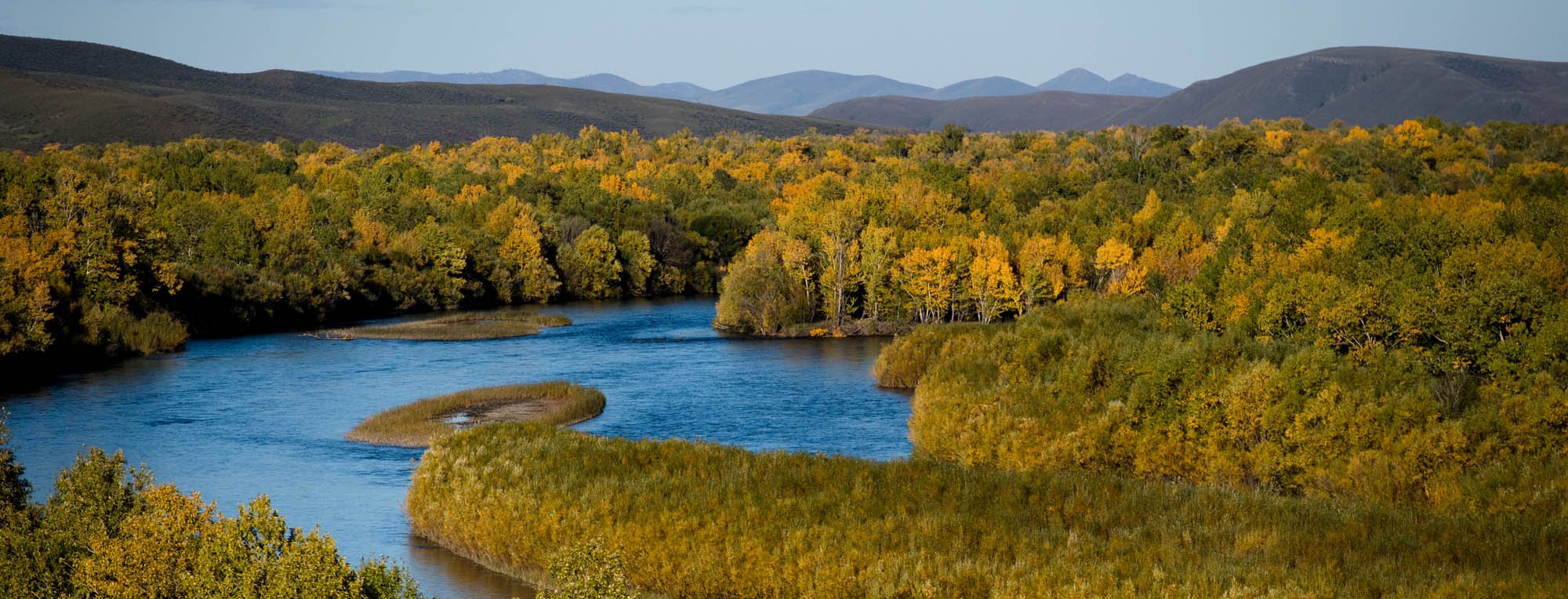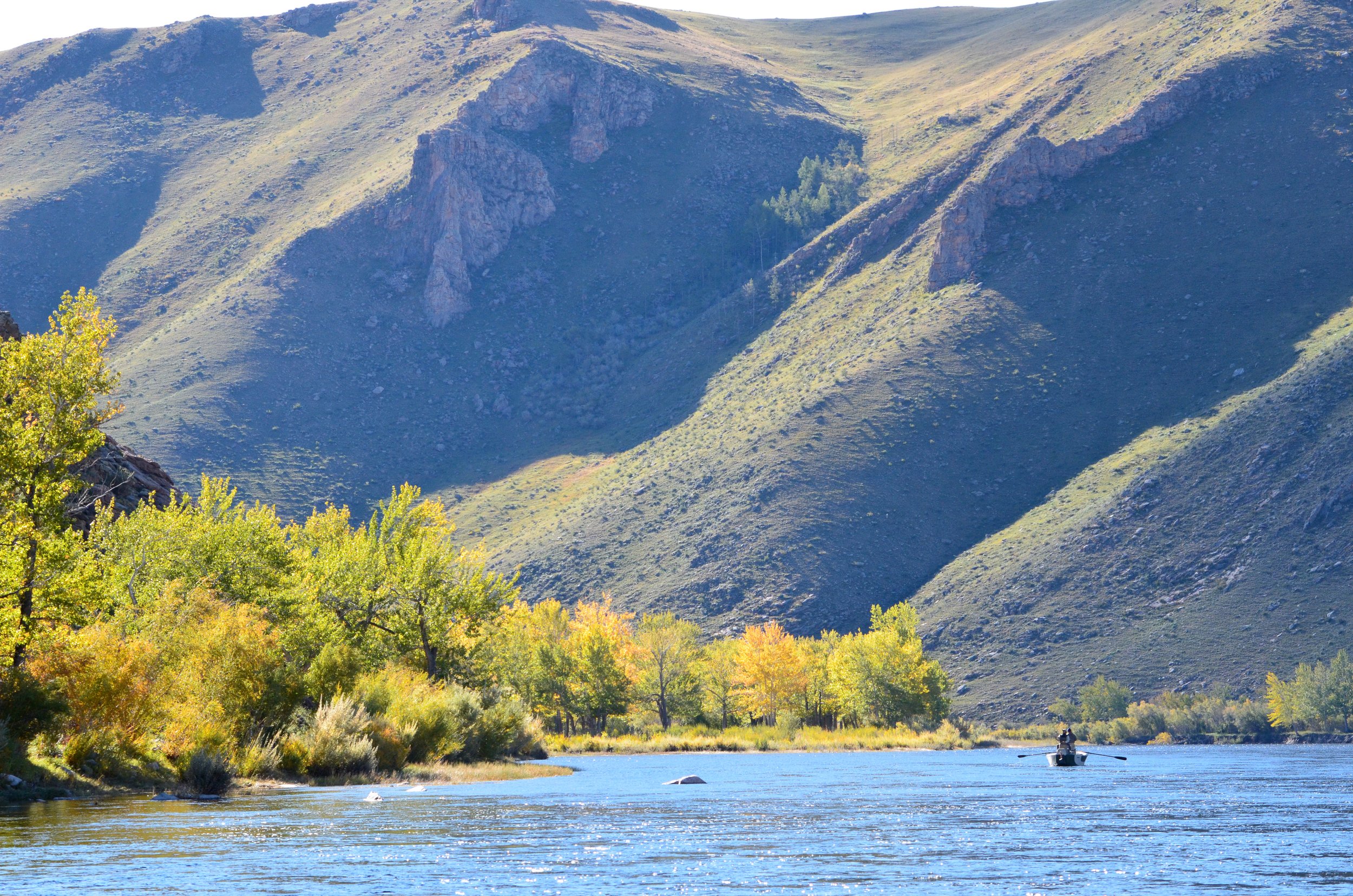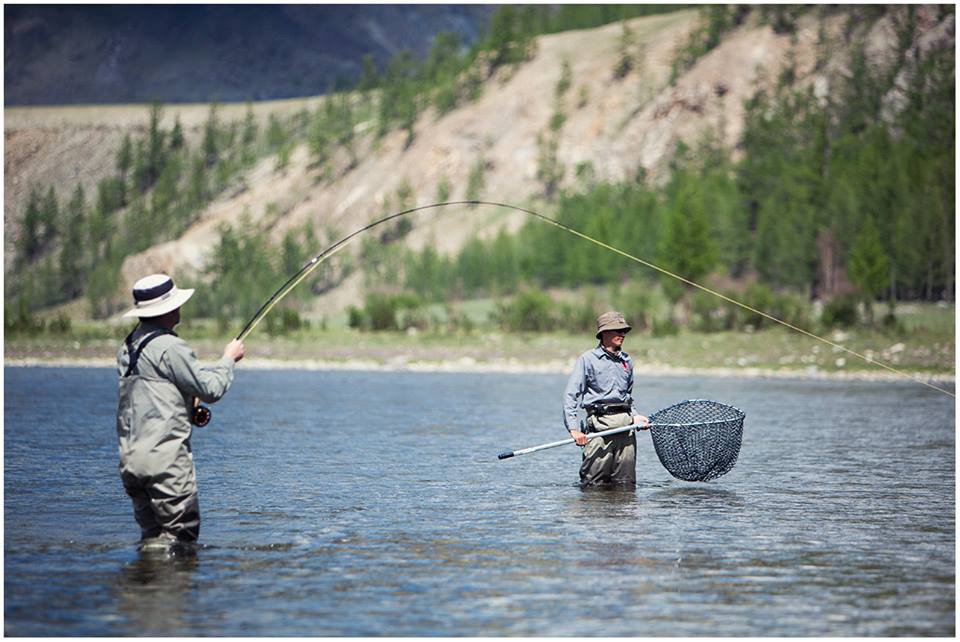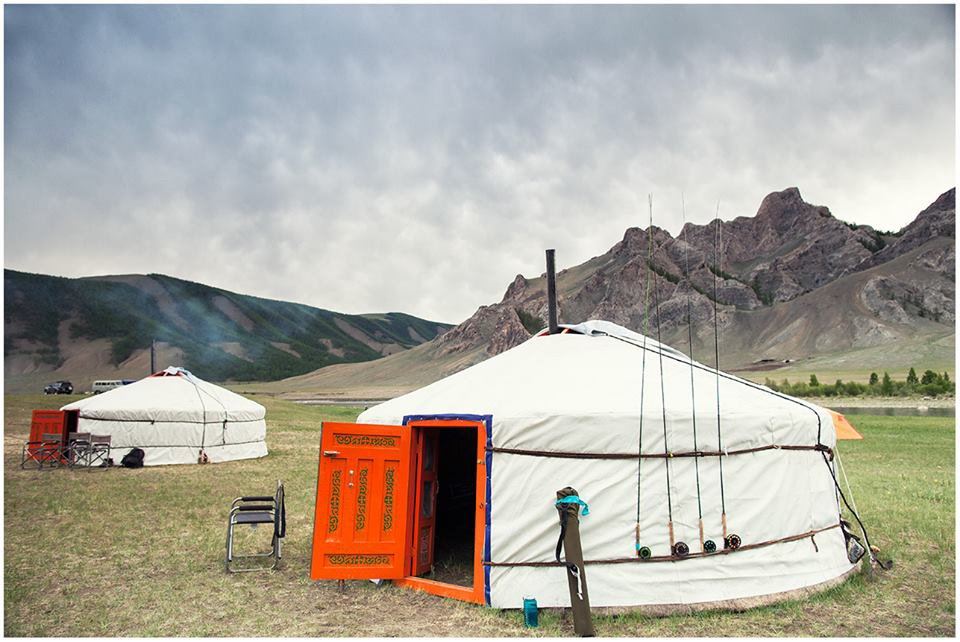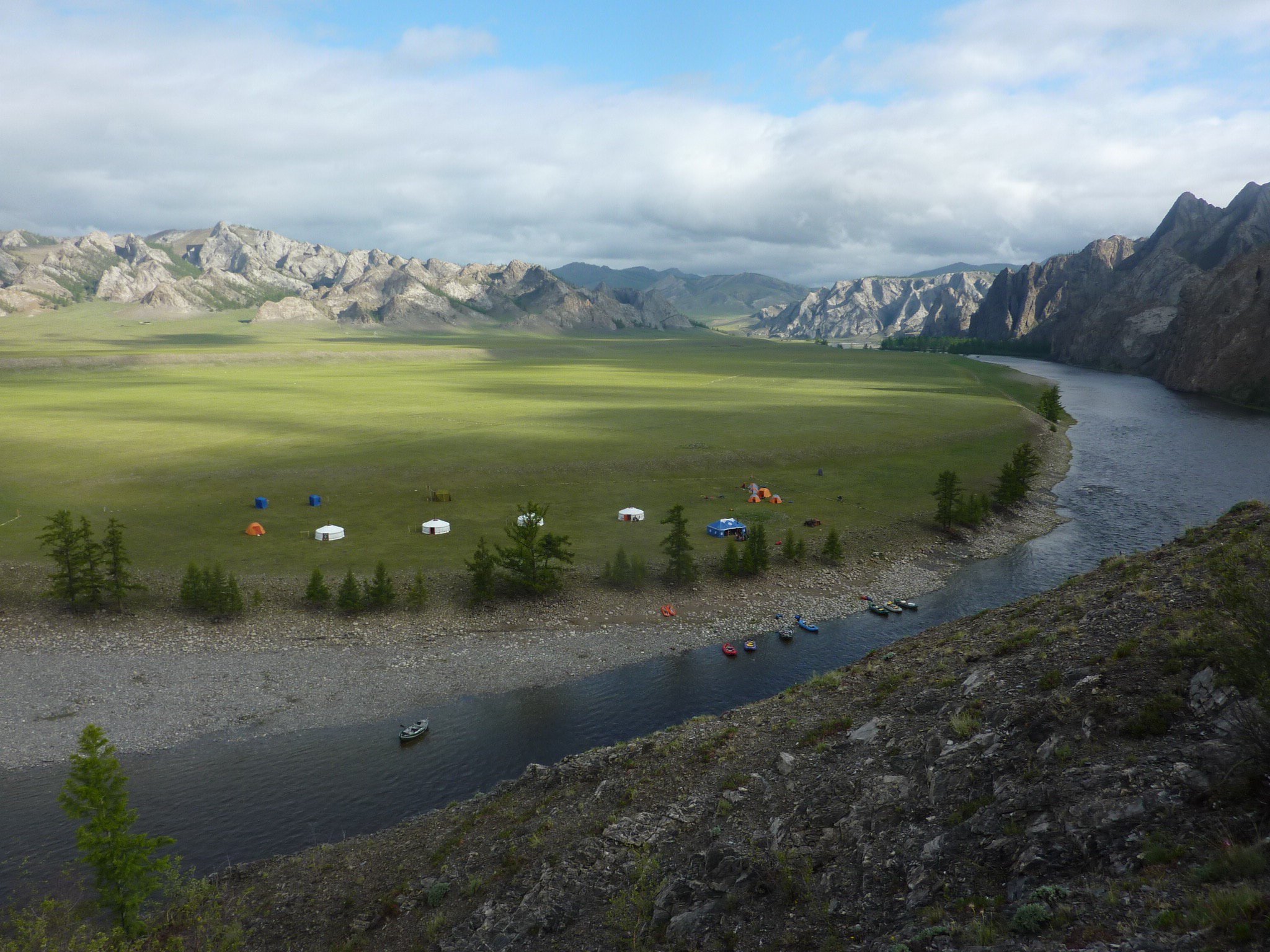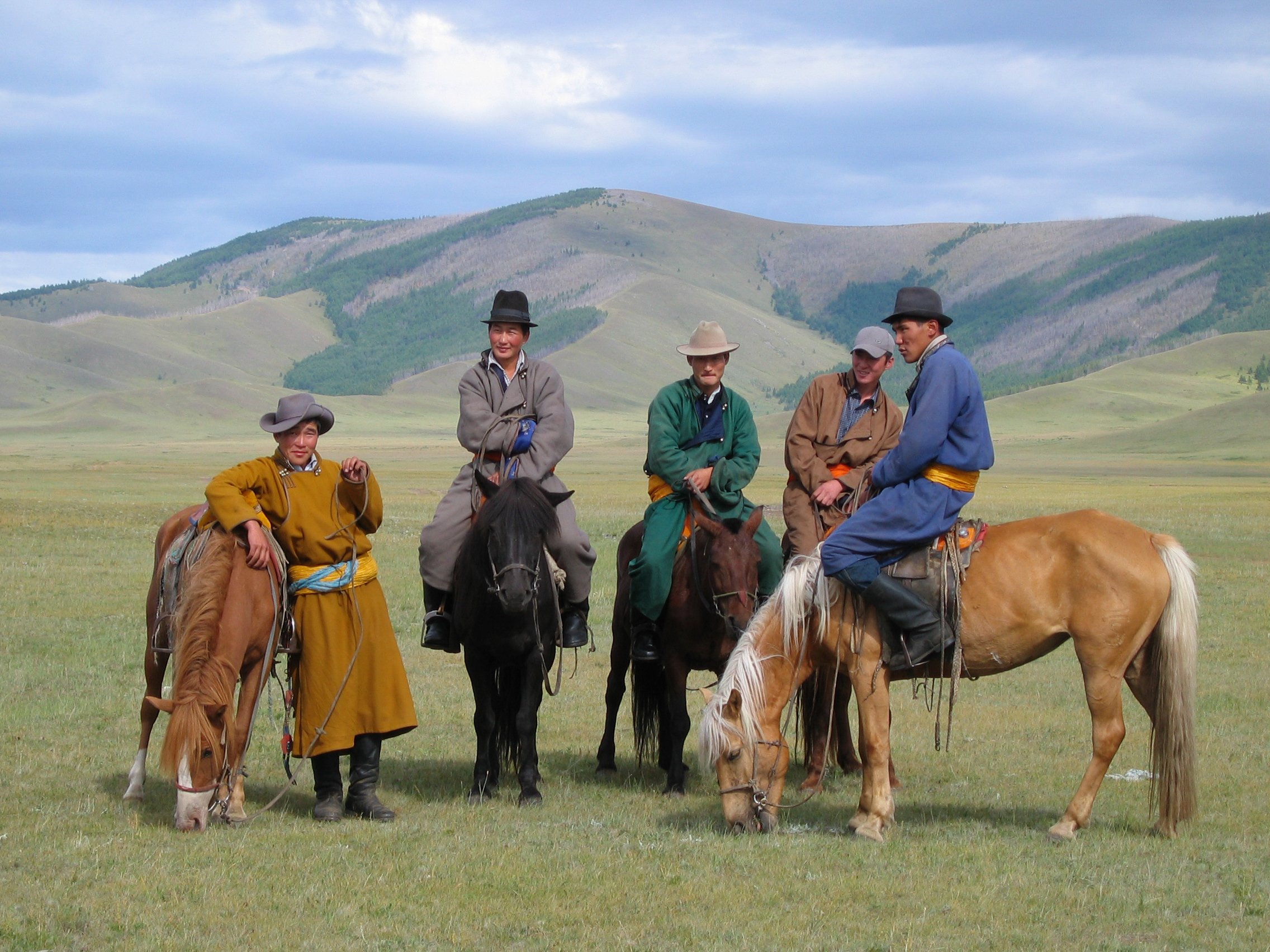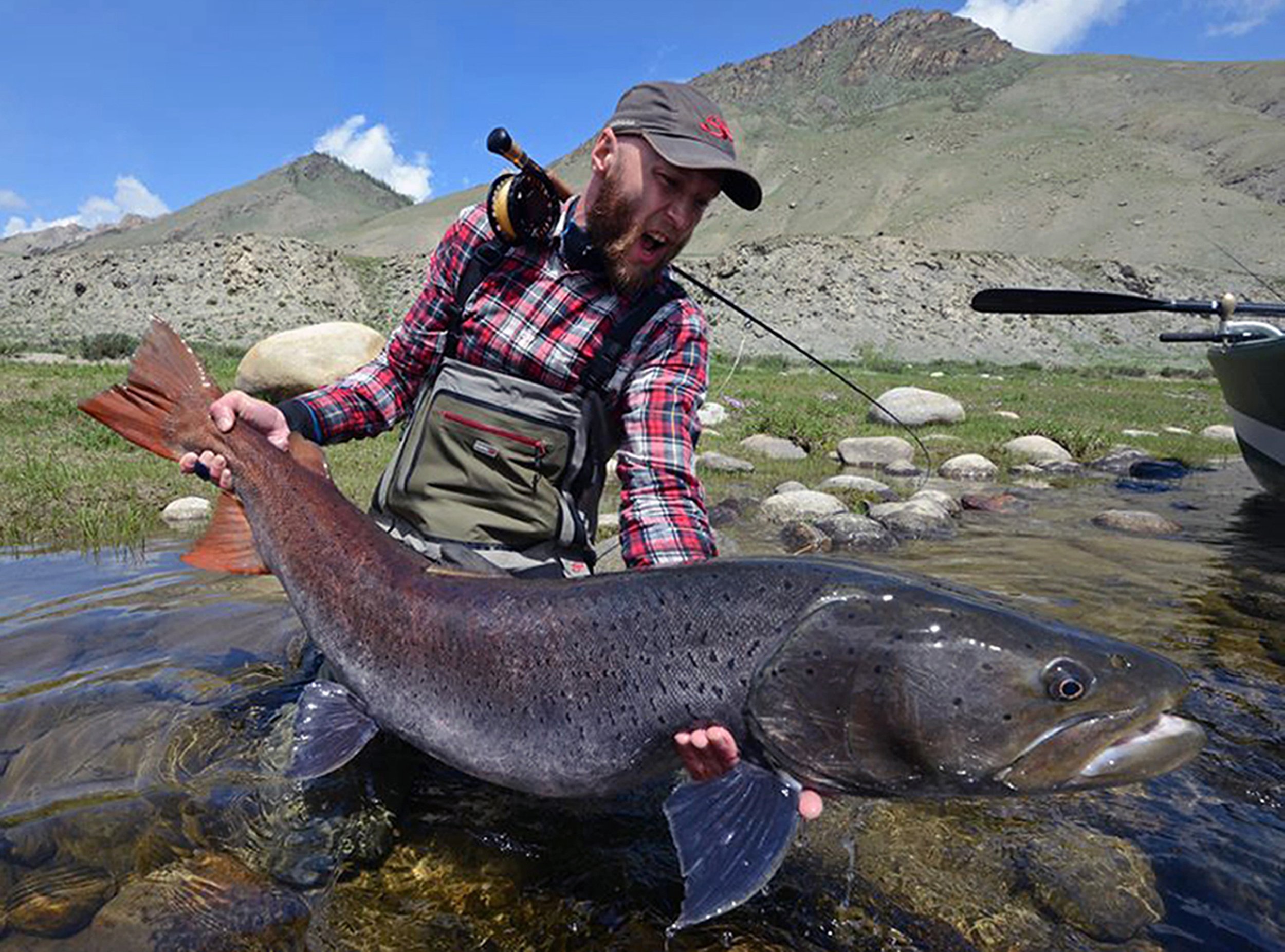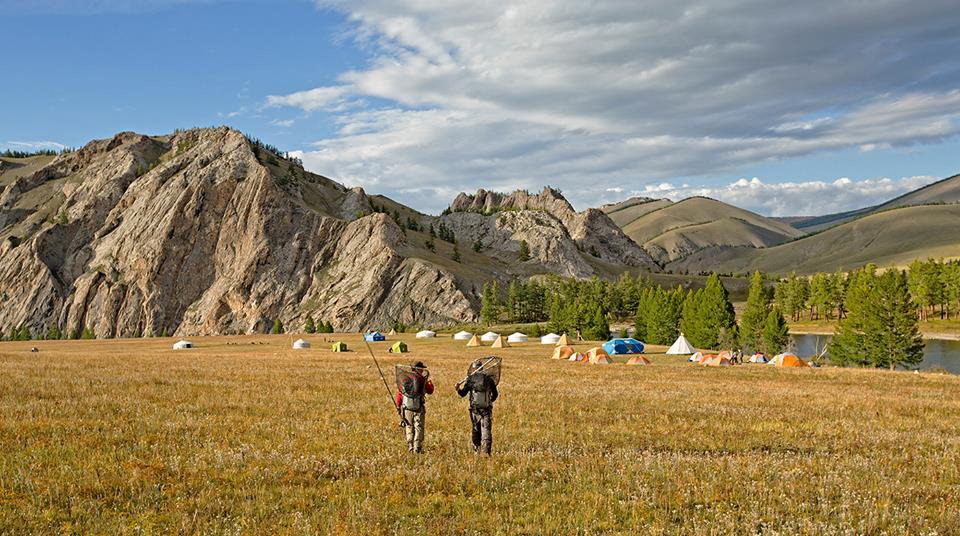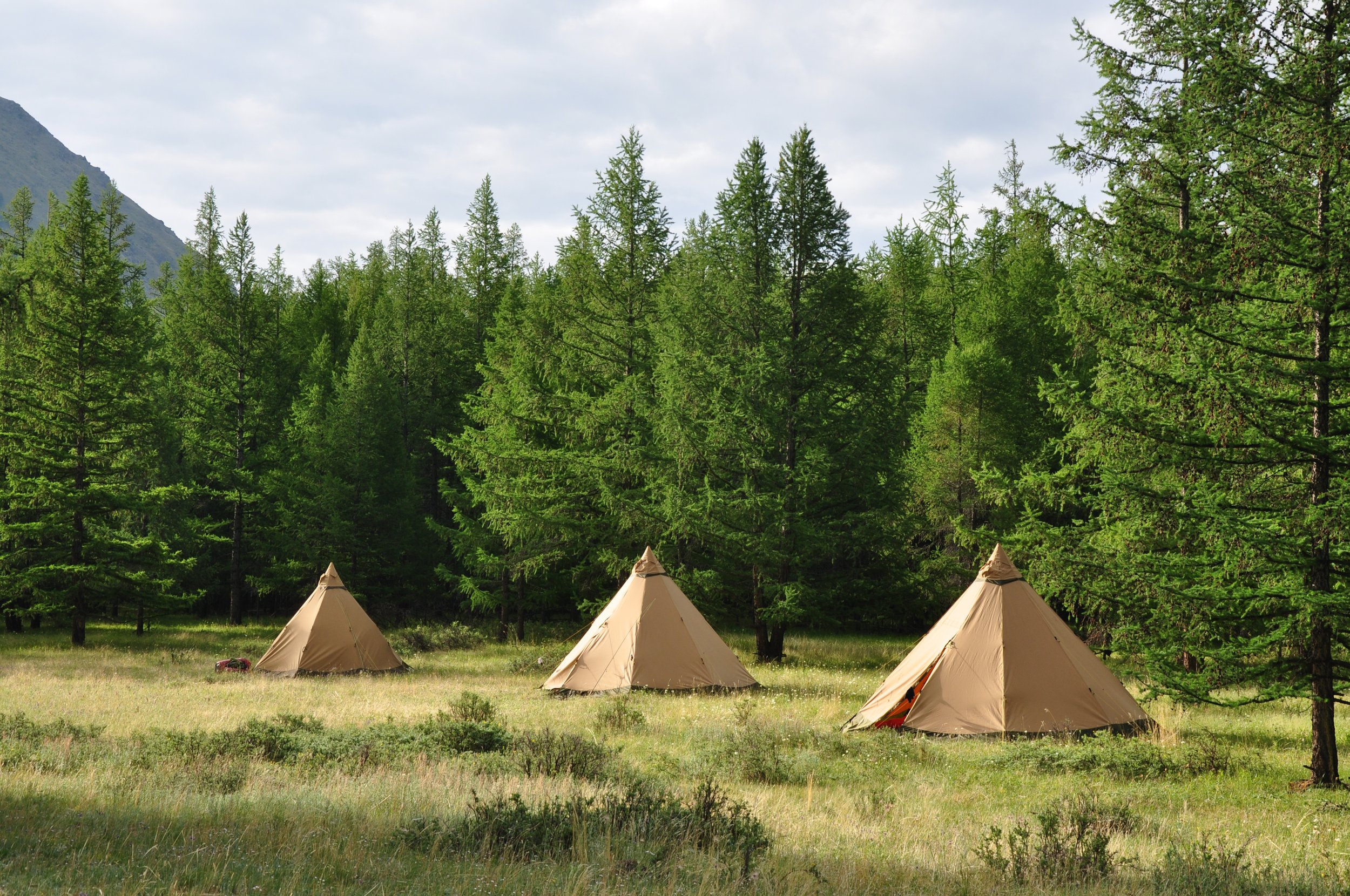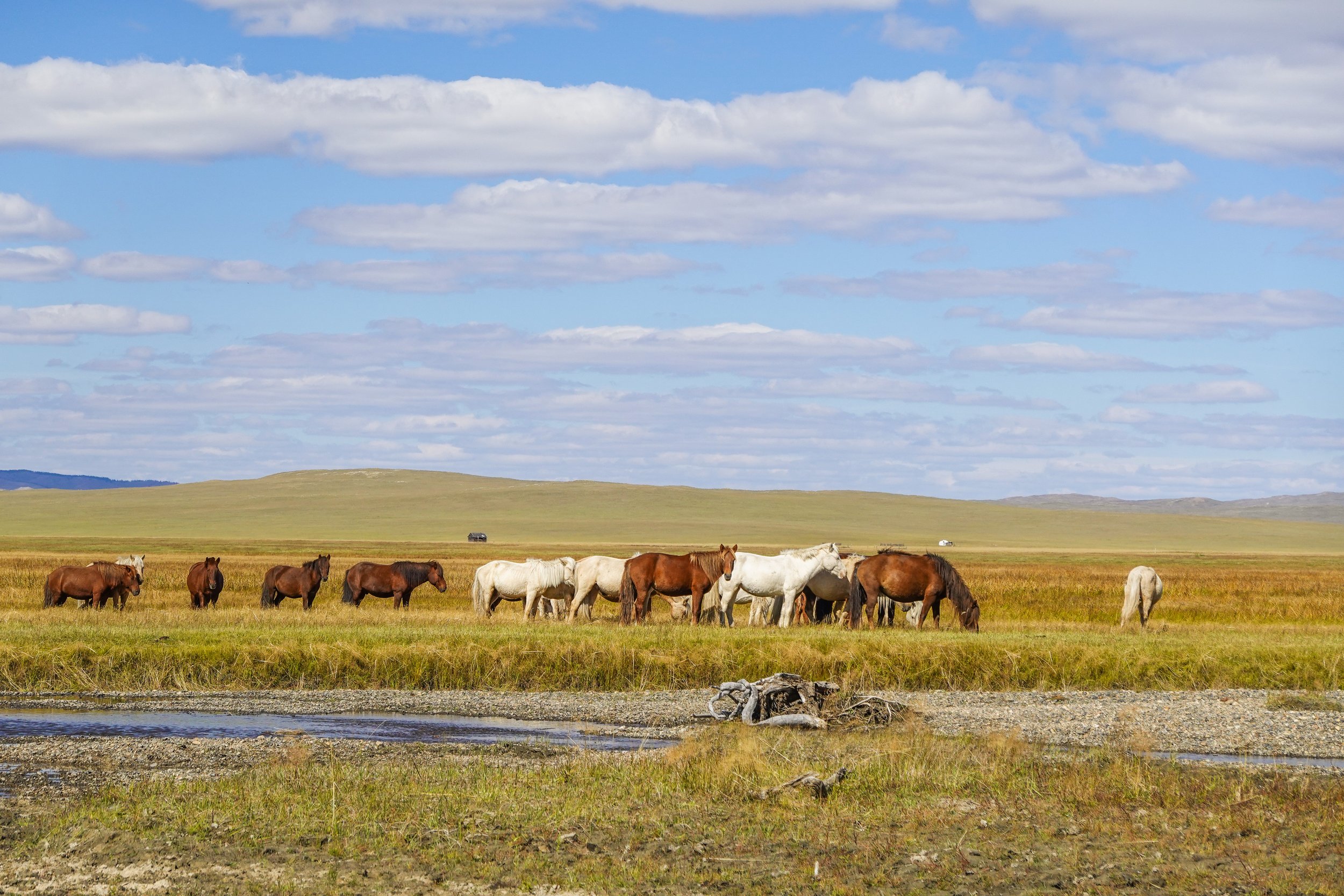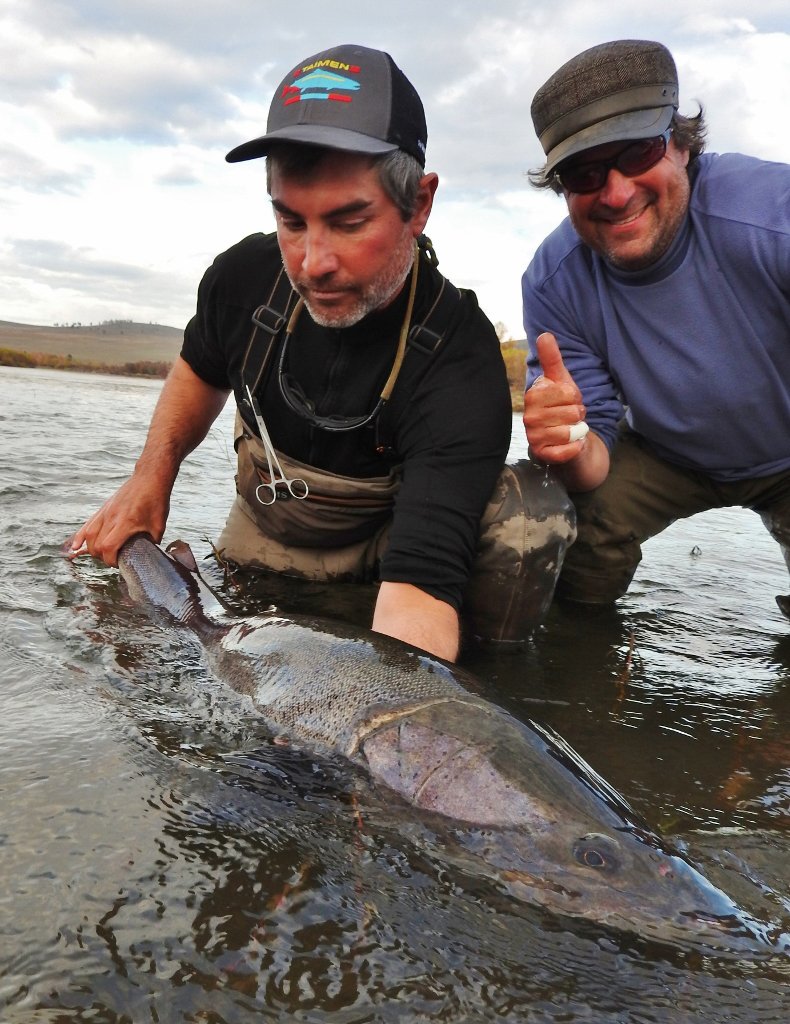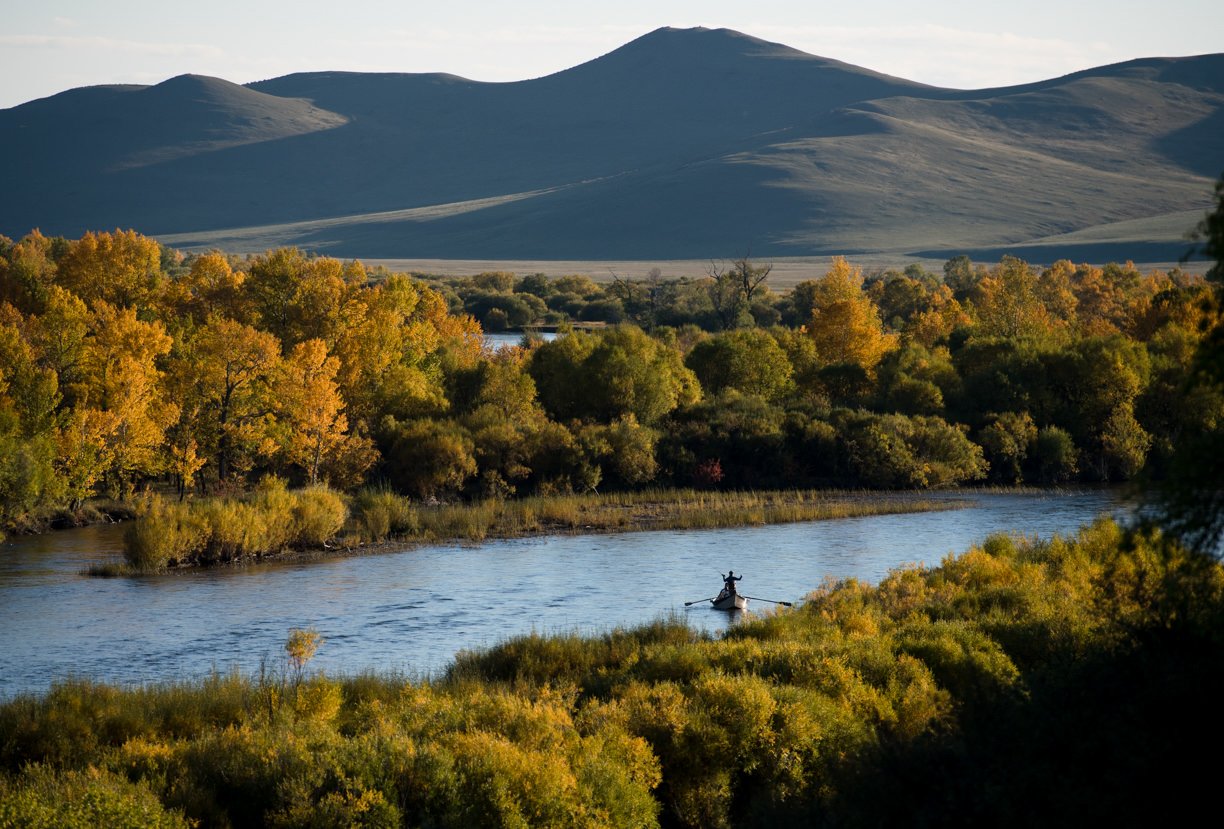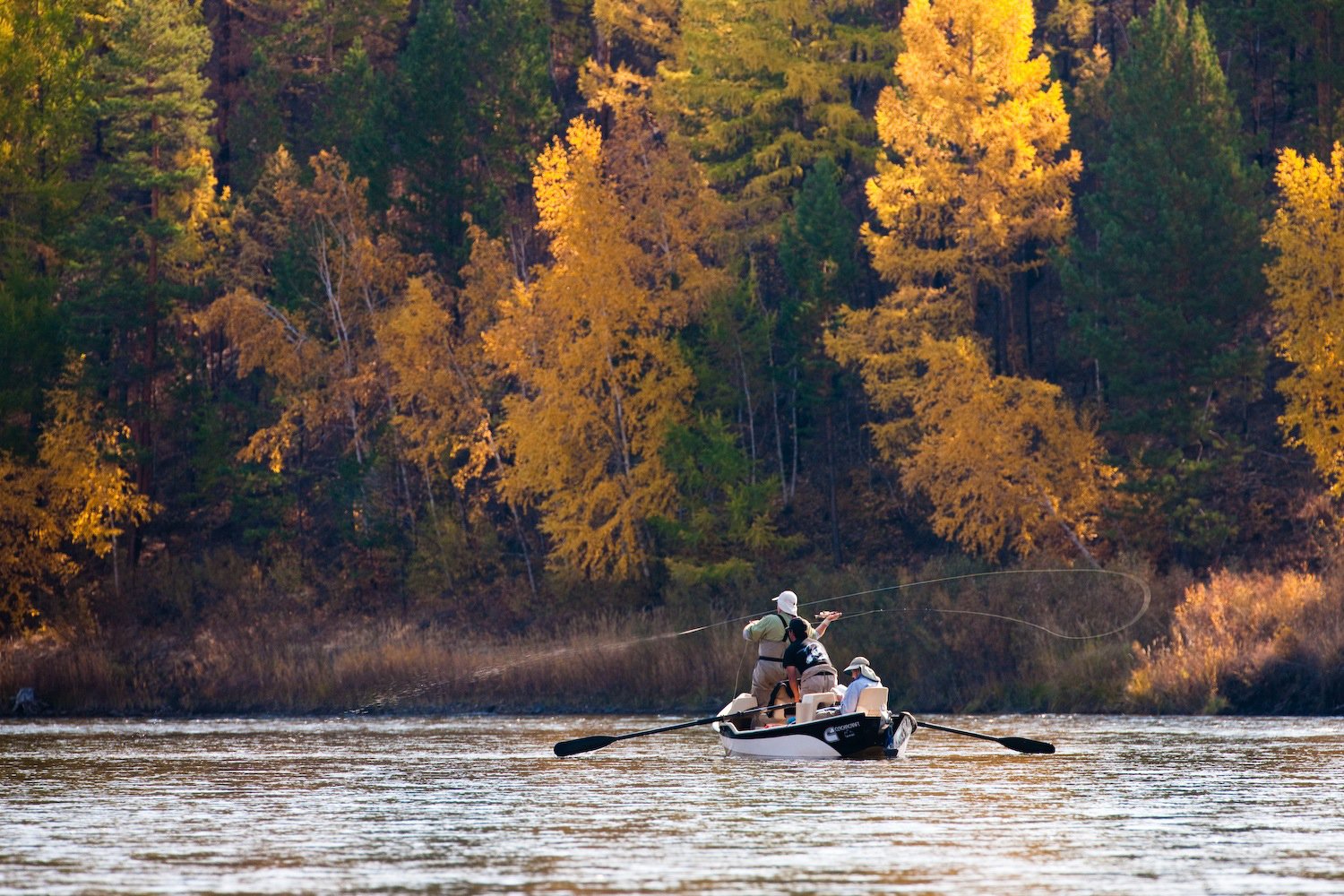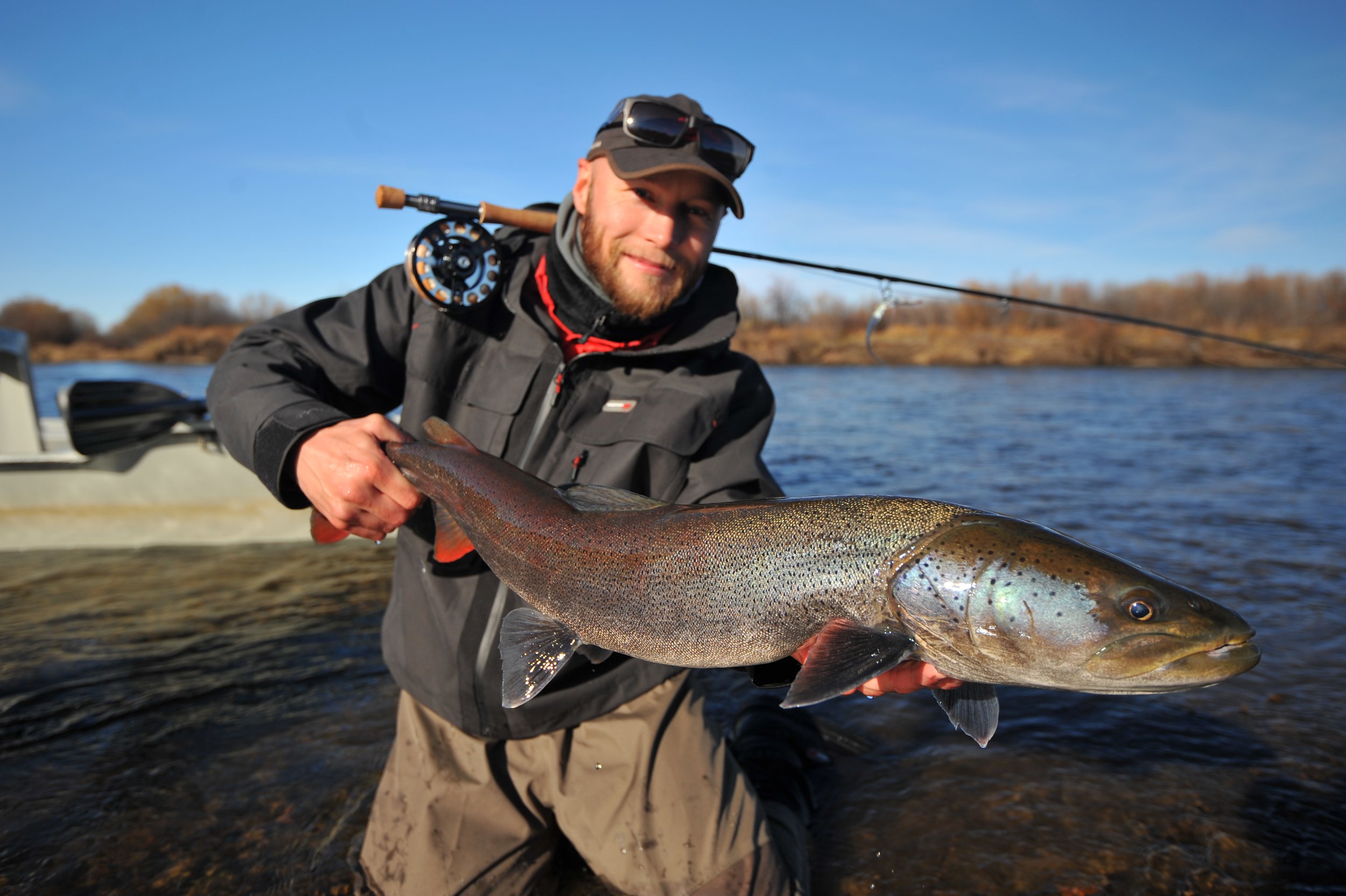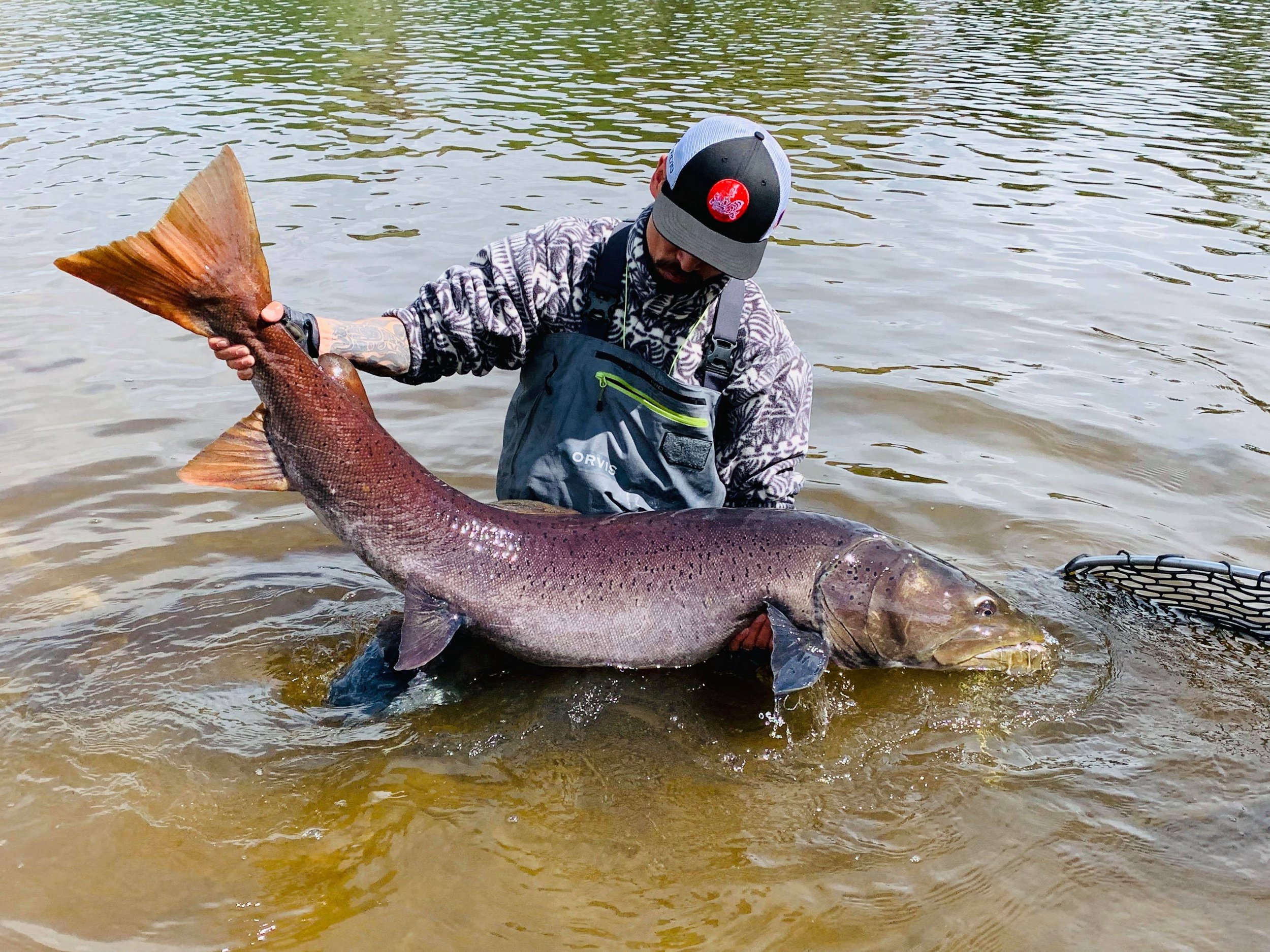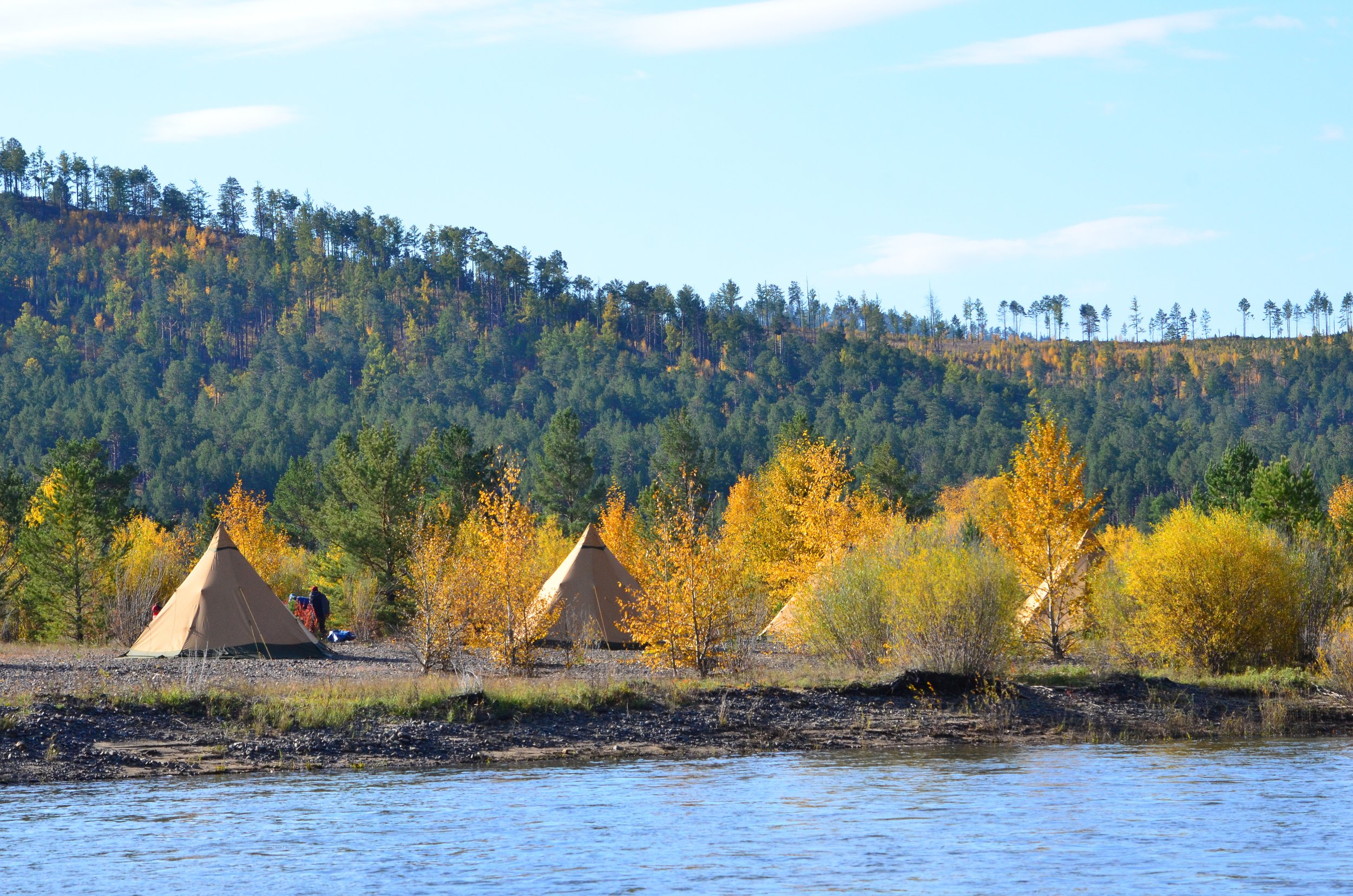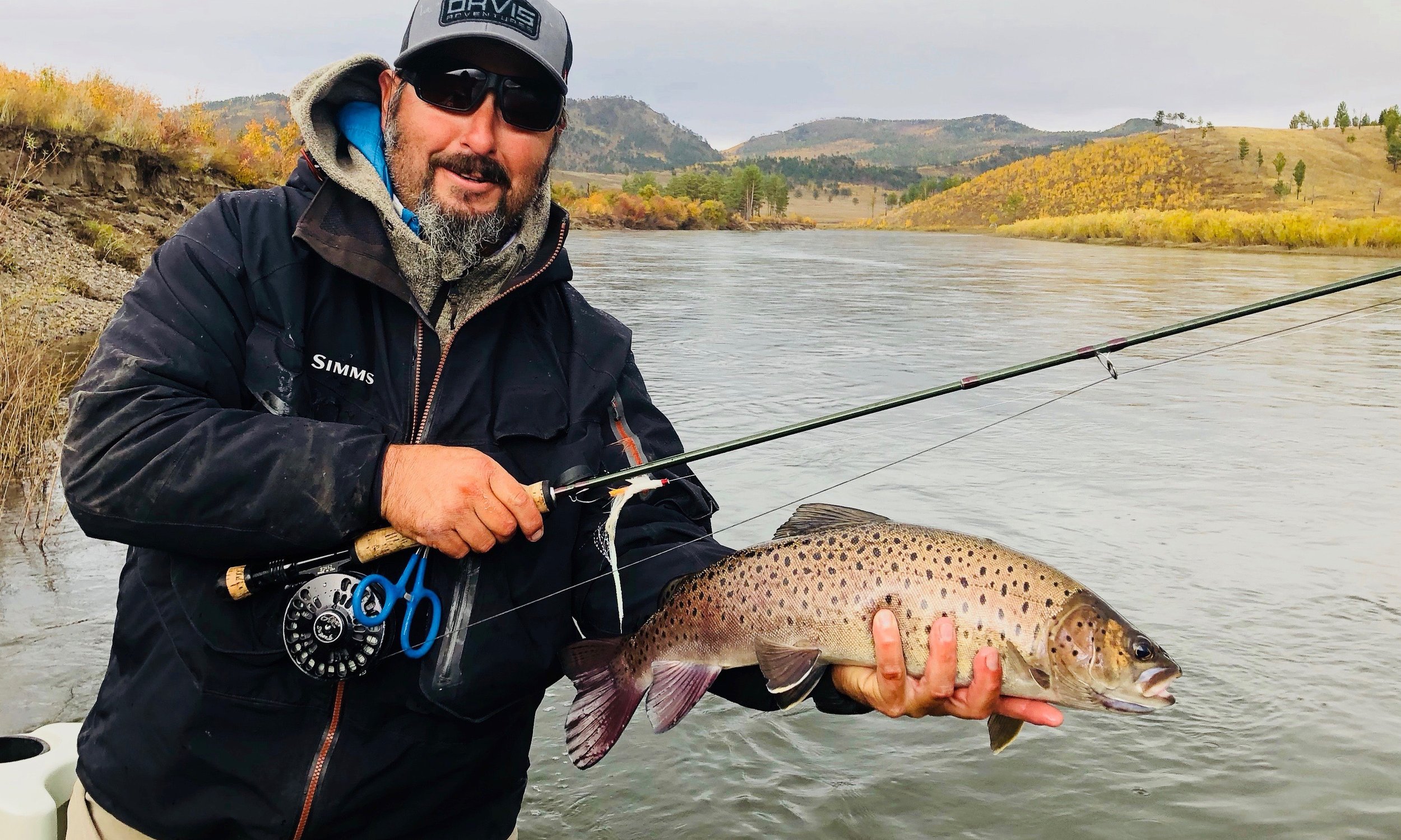Introduction
FLY-FISHING FOR WOLVES IN MONGOLIA by Cristian Dufflocq
Mongolia is one of the most beautiful places on earth and believe me; I know about the subject of natural beauty because I work as a fishing guide in Patagonia and the Chilean Fjords, plus I live in Montana and yes, I have been to Glacier National park and surroundings a few times. If you think this is not enough authority judging natural beauty, let me inform you that my wife has driven me (on the wrong side of the road) all over her native New Zealand.
If you are a fly-fishing enthusiast, hiker, visual artist, birdwatcher or just someone who enjoys nature, you should put a trip to Mongolia on the top of your list for next year’s early autumn. So far, I have been to Mongolia twice, both times to fight with 40+ Inch Taimen (Hucho Taimen, the largest Salmonid in the world) and, dry-fly sipping, Lenok and Grayling on the magical rivers of Northern Mongolia, and I will go back.
The first thing that strikes you as soon as you get close to camp and river is the shear beauty of the place and its huge scale. We had 75 miles of a gin-clear pristine river for only a few anglers, a much appreciated luxury. But the water available to us was even greater because the river has hundreds of smaller braids, some of them several miles long, most of which nobody has ever touched. Continued at bottom of page>>
UPPER RIVER FLY FISHING ADVENTURE (Late August-September-October)
This is a classic Mongolia Outfitters week long journey, with six full days of fishing in a beautiful landscape, fascinating culture, professional staff, exceptional camps, and world-class fishing. A small group of anglers explore nearly 100 miles of pristine river, floating through the world’s first Taimen Sanctuary. You will cast for taimen, lenok, amur trout, and even pike on a fresh stretch of river every day, staying in a well-appointed, comfortable ger camp every evening.
Upon arrival in Mongolia, an English-speaking guide and driver transfer guests to a comfortable hotel in the vibrant center of Ulaanbaatar. Early the next morning, you’ll embark on an overland adventure, arriving at the first riverside camp in time to get settled in, rig up for your week’s fishing, and possibly even make a few casts before dinner.
Over the next week, anglers float between seven unique ger camps strategically placed along the river. The “no shuttle” policy means that anglers experience a new stretch of river daily. When we arrive at the evening camp, the professional staff has your bags waiting, beds made, fires lit, and dinner prepared.
After a week of exploring the Mongolian outback, anglers return to the capital city for a relaxing evening prior to the next day’s departure from Mongolia. This river is amazingly well suited for fly-fishing. The river is wide and gentle. There are no rapids, but the flow is steady with loads of interesting features, including plenty of riffles and pools. Besides a variety of fish species, the healthy riparian habitat is great for wildlife viewing. There are roe deer along the banks and massive Whooper Swans and flocks of waterfowl on the river. It’s common to hear wolves and bugling elk in the evenings and just about every year someone spots one of these shy animals crossing the river. Birds are generally the highlight, including numerous raptors, swans and Baikal teal spotted along the forested river bottom.
LOWER RIVER FLY FISHING ADVENTURE (September-October)
Seven days floating through a very beautiful and more remote stretch of the world’s first Taimen Sanctuary. These trips are designed for those who don’t mind just a bit of “roughing it” in order to discover a glorious river full of taimen, lenok, amur trout, and even pike. A small group of anglers will explore nearly 100 miles of pristine river. The entire angling experience – remote location, incredible fishing, world-class guides, unique culture, and outstanding wilderness accommodation - makes this trip feel like an absolute privilege.
Upon arrival in Mongolia, an English-speaking guide and driver transfer guests to a comfortable hotel in the vibrant center of Ulaanbaatar, the capital of Mongolia. Early the next morning, depart on an adventure-filled drive across the classic Mongolian-steppe, arriving at the first riverside camp in time for a delicious dinner.
Over the next week, anglers float in Clackacraft Drift Boats between unique camps strategically placed along the river. There are no “roads” in this remote section of the river, which is more remote than the upper river and closer to the confluence with the mighty Amur river, much of the river we float flows through a National Park, so all of the camp equipment and your gear will be floated downriver by the wonderful and helpful staff. By the time you reach each camp at the end of a long fishing day, everything will be set up and ready for you.
The Lower River is remote, making vehicle access nearly impossible along much of the stretch. On Lower River trips, guests are accommodated in wilderness camps outfitted with large, comfortable manufactured Tipi-style tents, spacious enough to stand up and store all your gear. Tent Tipis are set up for two anglers per tipi on comfortable cots. All of the camps have simple shower and toilet facilities located in specially designed tents.
The pace is relaxed and depending on river conditions you’ll have plenty of time to get out and wade interesting stretches with your guide. The fishing is consistently good through all sections of the river.
This river is amazingly well suited for fly-fishing. The river is a bit wider down here with a couple of tributaries coming in from the north. The river frequently braids up into a myriad of channels sometimes giving it a small stream feel. There are massive cliffs where hungry taimen lurk, waiting in pools for unfortunate rodents to slip and tumble into the water. The back sloughs down here are a haven for big Amur pike. There are no rapids, but the flow is steady with loads of interesting features, including plenty of riffles and pools. Besides a variety of fish species, the healthy riparian habitat is great for wildlife viewing. There are roe deer along the banks and massive Whooper Swans and flocks of waterfowl on the river. It’s common to hear wolves and bugling elk in the evenings and just about every year someone spots one of these shy animals crossing the river. Birds are generally the highlight, including numerous raptors, swans and Baikal teal spotted along the forested river bottom.
This is a great choice if you enjoy expeditions and want a chance to chase big fish in a very remote environment. The Lower Expeditions are an amazing adventure to a place very, very few people ever get to experience.
BURYAT HEADWATERS EXPEDITION
Remote, Expedition-Style Taimen Fishing
The Buryat Headwaters Expedition covers the upper third of the taimen sanctuary and is designed for adventurous travelers. This is a six full days of float fishing with an additional half day wade-fishing waters close to Camp1 on arrival.
With a maximum of four guests per trip, this is a very unique opportunity for a small group of anglers to have nearly one-hundred kilometers of taimen water to themselves for a week. If conditions are right, we might set up a few ger camps on the Buryat. However, most years, guests will stay in Nordic tipi style camps maintained by your team of private cooks, camp staff, and guides.
This part of the river is very much like fishing a medium-sized mountain stream in the American west… except for the very, very big trout. There are lots of shallow runs, tight river channels, nice ripples and deep pools. The diversity of water and habitat up here is endless. If you like to get out of the boat and fish, this part of the river generally offers many more opportunities to wade than the lower stretches sections described above, as those have deeper sections.
The taimen fishing on the Buryat is outstanding with good numbers of big fish. The river up here is smaller, but the taimen are not. You will likely do quite a bit of site casting for taimen if you float this stretch.
The Buryat is an excellent choice if you are interested in finding large Amur trout. These are very unique fish and super fun to target with light weight rod. They will often be very willing to hammer a mouse fly. The whole stream presents great trout habitat, including a couple of channels that fish like spring creeks and several small tributaries, which are hardly ever fished, that you are welcome to check out as well.
Taimen Float Trips
The rivers are remote and difficult to access, offering pristine and secluded angling. There are very healthy taimen populations with fish over 50-inches encountered every season on both rivers. Boat travel is the only way to properly discover these rivers. We have a string of well appointed camps set out along the core section of the rivers; guests float with professional guides for days on end between camps, enjoying the beauty of this exotic landscape and marveling at its wonderful fish.
Boats are deluxe Clackacraft fiberglass drift boats. The boats are all quiet and stable, easily accommodating two anglers and a professional guide. They have comfortable seats and large, secure casting platforms, with plenty of storage space for spare rods, camera gear, snacks, drinks and other necessities. Every day you will cast over a new stretch of productive river. Lunch is served streamside by our great camp staff. You fish as long as you like without ever having to use a shuttle. Every evening you float into a stunning camp where the drinks are cold, the fires are warm, and the food is delicious. The next morning, you get up and do it all over again
RATES & DETAILS
Remember that our services are completely free! When you book a trip with us, you pay the same rate than when you book directly with the lodge or outfitter.
One week: Upper, Lower & Headwaters section of Onon river...............…...…..US$7,500 per person
Two weeks: Combo Trip Upper-Lower or Headwaters-Upper Onon river......….US$13,500 per person
Three weeks: Combine all three sections with 20 days on the river………….US$18,500 per person
Group Sizes .................................................................... 6 anglers (Upper & Lower); 4 Anglers Headwaters
Dates: Late August to October
River: Majestic eastern Onon river with lower elevation and rolling mountains offering outstanding taimen and trout fishing. Located at north 48th parallel with warm summers and cool autumns.
Fish: Taimen, Amur trout, Mongolian trout (lenok), Amur pike, and asp.
Travel: Ulaanbaatar is serviced by regular flights from: Seoul, Istanbul, Tokyo, Moscow, Beijing, and Hong Kong. Some nationalities require a Mongolian travel visa, easily obtained through a simple on-line application. USA citizens do not require a visa.
Transfers: Trips begin and end with international arrival/departure from Mongolia’s capital city, Ulaanbaatar (“UB”). Driver and guide greet you at the airport and manage all transfers.
Accommodation: Guests enjoy single, non-sharing hotel rooms in UB. River accommodation based upon two anglers sharing a spacious ger or tipi (depending upon trip). All camps have simple toilet and hot shower facilities. Excellent meals. Professional chefs. Dozens of seasonal camps protecting nearly one-thousand kilometers of wild and productive river.
Guides: Mongolian and international guides. Two anglers fish with one guide. Guides rotate daily so guests fish with variety of individual experts. We fish new water daily with no shuttles.
Inclusions: Two nights hotel in UB (arrival/departure), airport transfers, transportation to/from the river, permits, guide services, and all meals, lodging, soft drinks, beer, wine, and Mongolian vodka at camp. Excludes UB meals and drinks, gratuities, visa fees and international airfare.
Equipment: Outfitter supplies all flies. Anglers bring personal items, suitable fishing clothing and tackle. We provide a detailed packing list. Best taimen rods: single handed 8 – 9 weight. Best trout rods: single handed 4 – 6 weight. Taimen: dry-fly and streamer. Trout: primarily dry.
Conservation: Founded to help protect Mongolia’s scenic rivers and native fisheries. Assisted local communities to designate both rivers special “Taimen Sanctuaries”. Carefully managed fishing program. Non-motorized, fly-fishing only and catch/release single, barbless hooks.
Introduction Continued…
I kept repeating to myself… This is so difficult to describe but, the first thing that came to mind was… this is like living inside a National Geographic magazine! The bright autumn colors reflected in the gorgeous waters under perfect sunny weather, exacerbated the beauty of the surroundings and was beyond the limits of what I thought possible.
If this was not enough, adding to all this beauty were the people. Mongolians are extremely nice, happy and very proud of their country. The camp’s staff was mostly Mongolian, except for a few guides from my native Chile. They all worked hard to make us feel welcome and to make sure the place ran like clockwork. Let me stress this point, we were really impressed by their punctuality and consistency. Guides went out of their way to put us into good fish, and they managed to keep everyone very happy.
To this point, I have not mentioned any details regarding the actual fishing experience, which is the reason many of you are reading this story but not to worry, I’ll tell you all about it as soon as I finish setting up the scene.
The cultural element of the trip is what makes it so special and cannot be overlooked. Consider that we were fishing in one of the most remote corners of Mongolia, but with a history of several thousands years. There were elements that impressed us all, particularly coming from America where anything over 100 years old is considered an archaeological relic worthy to be displayed at the Smithsonian.
One afternoon we were invited to visit a sacred valley close to camp, located a short 20 min. drive (along what Mongolians call a “road”, but to us would hardly qualify as a trail) where our guide pointed out several burial mounds dated prior to Genghis Kahn’s era, which means anything over 800 years ago. Then he told us to walk along a trail that went slightly upwards towards a rock cliff. Soon we were in front of an enormous granite boulder, at least 30 feet in diameter, with inscriptions in archaic Tibetan carved by a Buddhist monk many years ago which went all around the rock. It was a mantra or sacred Buddhist sentence carved 10 thousand times into the rock. Did I mention that the view towards the valley below was also spectacular?
On another day we followed the river for more than an hour, stopping to fish along the way, when the guide said, “Do you want to see the Blue Buda?” Sure enough, on a large rock overlooking the river, we found an ancient painting of a Buda done in shades of blue, which to Buddhist is a sacred color depicting the heavens or sky. Feeling very spiritual, I immediately prayed to catch a fish right there but, not surprisingly, it was clear the fish had a more direct connection to god.
We were happy anyway, the trip along the river was a worthy experience in itself, after every turn on the river you encountered the most beautiful natural scene you’ve ever seen, only to be proven wrong the next 10 seconds. It was an aesthetic overdose.
We also passed several local Nomad camps along the river, at one of which we stopped to say hello, take pictures and to unload my stash of chocolate coins into the open hands of smiling kids who, to this day may be thinking a couple of extraterrestrial beings dressed in space suits from the Simms planet arrived riding the waters on a floating craft and presented them with heavenly tasting confections. I hope we did not scar them for life or that we are now deities, perhaps even part of a new religion.
Taimen are hunters, the locals, very appropriately, call them “River Wolves”. The only difference would be that these fish don’t hunt in packs, which could be an entirely possible behavior. Anyway, these fish are voracious and it will help you to remember that one of their most common strategies is ambush.
Taimen mostly hunt fish but they will attack birds or mammals stupid enough to venture into slightly deeper waters. I have read scientific papers with pictures of 5 lb. rodents coming out of Taimen’s stomachs. I also saw the lures locals use to catch them; the most common one is an 8 inch long cork cylinder covered with a ground squirrel’s skin and a couple of obscenely large treble hooks, it is fished dry in case you are taking notes.
To fish for Taimen you aim towards places were these fish could set an ambush, deep pools, drop offs were particularly productive, even ones where the current seemed to be coming in too fast or along steep banks. Seams, where two currents get together, are also productive.
Taimen are big and powerful, they may not run like a Salmon or Steelhead but they pull relentlessly so if you do not pull back and hard, you are going to be there for a very long time. A 36 inch Taimen took me to the backing twice and, the fight might have not taken that long but, I sure was glad it was over.
We fished with dries imitating semi-dead fish or small rodents, it was important that the fly disturbed the surface of the water creating a “v” shaped wave and a small splash. Wet flies imitated, you guessed it, fish. These were weighted, large and colorful; combinations of red, yellow and electric blue seemed to be good colors. Did I mention these flies were hard to cast? Well they were, so remember to take pauses in order to rest your arm during the day. Luckily this practice introduced me to one of the most interesting aspects of this fishing experience.
After a few of hours of Taimen fishing, when I was about to ask the guide for a well deserved pause, he suggested we fish for Lenok and Grayling using my much beloved 5 weight, medium action Winston rod. Oh how wonderfully familiar and pleasant it was to go back to dry fly-fishing for delicate sipping fish of a more “normal” size, not like atomic subs. It was like switching from African game to Quail hunting.
Lenok and particularly Grayling, delicately sip insects, they’ve mastered the art of not disturbing the surface of the water while feeding on top. This makes it particularly challenging when fishing for rising fish in faster water but, not to worry, there is plenty of flat water.
A size 12 Adams parachute or the ever-trusty Royal Wulff worked wonderfully with a 4x tippet. Fish were abundant and cooperative. Grayling had an average size of 14 inches and 18 inches for the Lenok. The guide told us Grayling can grow over 20 inches and Lenok up to 30, my best Lenok was 23 inches, 16 for the Grayling.
When you come to Mongolia consider setting aside at least two half days to dry fly-fish for Lenok and Grayling with light tackle. Tell your guide to take you to a small side channel and to set you free to dry-fly fish upstream for an entire afternoon. It is bound to be one of the best dry fly-fishing experiences of your life and will complement so well with the exciting fishing for the ”River Wolf” making your trip a much richer experience. I sincerely belive that if there were no Taimen in the Mongolian rivers, anglers would be traveling there for the dry fly-fishing.
Not counting, the much appreciated Grayling and Lenok, everyone in our group caught Taimen over 40 inches plus several in the 30-35 inch range, which are all very good fish but one very excited lady was the undisputed champion with a 48-inch beauty.

